Movie Review By: Mr. Roboto
Year: 1971
Directed by: Stanley Kubrick
Written by: Stanley Kubrick, based on the novel by Anthony Burgess
IMDB Reference
Degree of Cyberpunk Visuals: High
Correlation to Cyberpunk Themes: High
Key Cast Members:
Alex de Large: Malcom McDowell
Frank Alexander: Patrick Magee
Dim: Warren Clarke
Gerogie: James Marcus
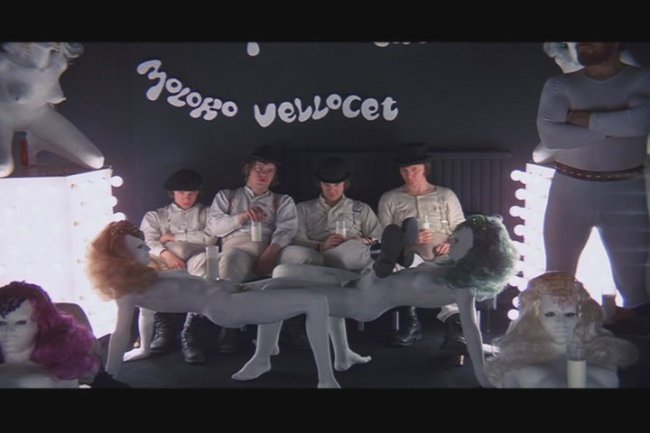 Overview:
Overview: Unquestionably, A Clockwork Orange has to be among the most recognizable names of pre-cyberpunk works, invoking surrealistic images of the old ultra violence, sex done to the William Tell Overture, models of naked girls as tables and beverage dispensers, chemically induced behavior modification, the threat of Karma,… and a bit of Beethoven for good measure. It has often been cited as inspiration for cyberpunk novels, and even Rob Zombie salutes the film in his video for “Never Gonna Stop (The Red Red Kroovy).” The subject matter, while speculating about 1995 from a 1960’s view, is still surprisingly relevant for 2007. With themes of street gangs, youth against the elderly, and forced behavioral changes against free will, one can swear the movie was more recent.
But can it be called a cyberpunk movie? There’s no question about the “punk,” but in all honesty, it’s a little thin on the “cyber” since there’s no ubiquitous access to information or man-machine fusion, though Alex does undergo a “reprogramming” in a skull-cap wired to machines to monitor his vital functions. The lack of “cyber” isn’t Mr. Kubric’s or Mr. Burgess’s fault, since nobody in the 60’s could have predicted the impact of computer technology when 1995 rolled around. It still doesn’t subtract much from this piece of cinema goodness that many agree is a timeless classic.
So grab a glass of milk mixed with your narcotic of choice, pull up a naked model table, brush up on your Nadsat, and vidi well, little brothers.
The Story: Starting at the Korova Milk Bar, Alex De Large and his “droogs” tear up the streets of a future England city, beating derelicts, fighting other gangs, raising hell on the roads, invading homes, raping women, then returning to the Korova for a nightcap when we learn Alex also has an ear for Beethoven. His fun comes to an end when, during a failed home invasion. Alex kills a woman and is ambushed by his droogs, leaving him for the police to capture, convict of murder, and sentence to forty years in prison.
Two years into his sentence, Alex learns of the Ludovico treatment. He wants to volunteer, but the Prison Chaplain expresses his doubts and tries to talk Alex out of it.
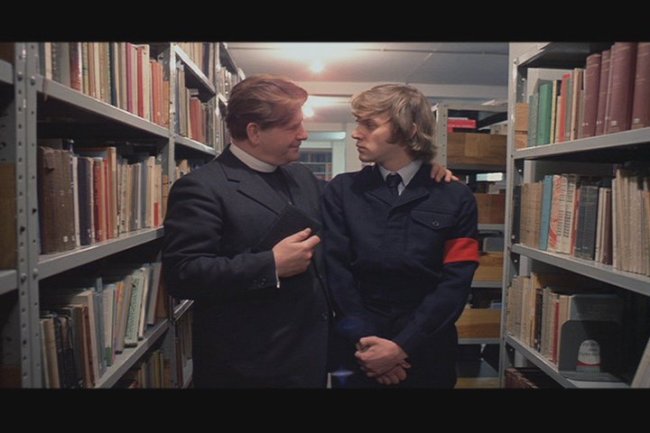
“The question is whether or not this technique really makes a man good. Goodness comes from within. Goodness is chosen. When a man cannot choose, he ceases to be a man.”
When the Minister of The Interior visits, he selects Alex for the Ludovico treatment. The treatment involves Alex being injected with an experimental serum and made to watch videos of violence and rape, where the serum causes unexpected results.
Dr. Brodsky (During Alex’s first “treatment”): “Very soon now, the drug will cause the subject to experience a deathlike paralysis together with deep feelings of terror and helplessness. One of our early test subjects described it as being like death. A sense of stifling or drowning. At this period we have found that the subject will make his most rewarding associations between his catastrophic experience, environment and the violence he sees.”
During one “treatment,” the doctors use Beethoven’s 9th Symphony as the background music while a Nazi propaganda was viewed. Alex objects to the use of the music, but the treatment continues, causing him to become conditioned to the piece.
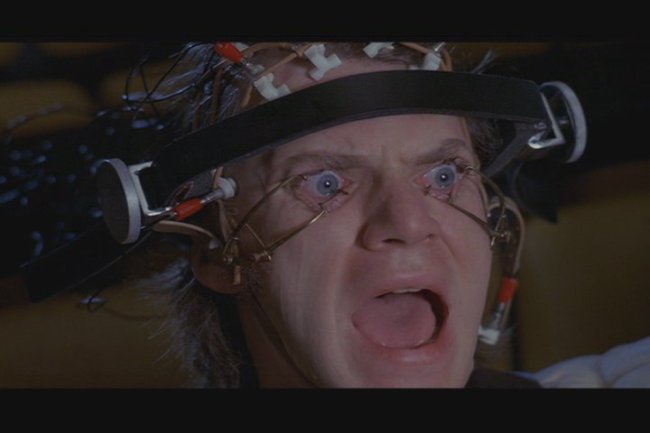
“Stop it! Stop IT! STOP IT! Stop showing NEW ROSE HOTEL! IT’S NOT CYBERPUNK!!!!!
After the doctors show Alex’s treatment worked, he’s released back into society. That’s when the Universe plays the Karma card…
Whose Pawn Is He Anyway? The theme of free will versus society’s programming is quite dominant with the implications of the Ludovico treatment, but an underlying theme of people being used as pawns for political and personal gain is noticeable, especially when Alex returns to the home of Frank Alexander, whose house he and his droogs invaded and whose wife they raped. At first, Frank only recognizes Alex as the boy who went through the Ludovico program and calls a friend who can use him:
Frank Alexander: “He can be the most potent weapon imaginable to ensure the government is not returned in the election. The government’s big boast, sir, is the way they have dealt with crime: Recruiting young roughs into the police, proposing will-sapping techniques of conditioning. We’ve seen it before in other countries. The thin end of the wedge. Before we know it, we’ll have the full apparatus of totalitarianism. This young boy is a living witness to these diabolical proposals.”
Frank doesn’t realize that Alex is the one who raped his wife until he hears Alex singing “Singing in the Rain” in the bath. He manages to get Alex to drink drug-laced wine to knock him unconscious. When Frank’s co-conspirators arrive, they lock Alex in an upper-floor room while playing Beethoven’s Ninth, causing Alex to attempt suicide. While recovering in the hospital, we see the old amoral Alex return when a nurse shows slides. The Minister of the Interior visits Alex to apologize for the treatment and offer a government job.
Alex used the people he encountered for his own amusement, including his own droogs. After undergoing the treatment, he’s unable to defend himself as those he tormented and attacked gain a measure of revenge on him. Then he’s used as a political pawn.
Conclusion: A Clockwork Orange is a difficult movie to describe. It’s not an easy view with it’s ultraviolence, rampant sex, and drug use, but it makes for an interesting movie nonetheless. It’s a sick, twisted, demented, deviant, weird, and totally fucked-up view of the future. In other words, a real good movie.
To show A Clockwork Orange’s place in history, I’ve edited the AFI 100 years, 100 movies post.
Movie Review By: SFAM
Year: 1998
Directed by: Darren Aronofsky
Written by: Darren Aronofsky & Sean Gullette
IMDB Reference
Degree of Cyberpunk Visuals: Medium
Correlation to Cyberpunk Themes: High
Key Cast Members:
- Max Cohen: Sean Gullette
- Sol Robeson: Mark Margolis
- Ben Shenkman: Lenny Meyer
- Pamela Hart: Marcy Dawson
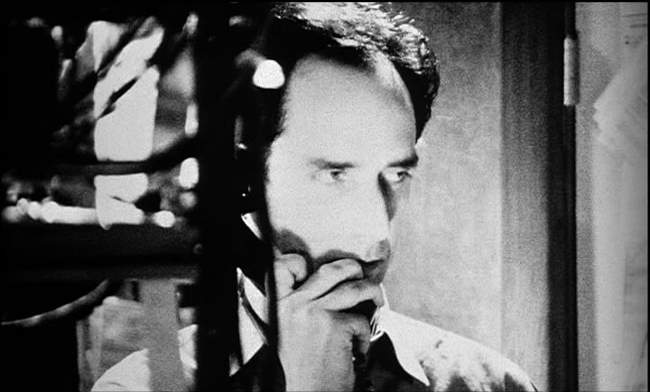
Overview: With a production budget hovering around $60,000, first time film director Darren Aronofsky teamed up with actor Sean Gullette to create a powerful addition to the cyberpunk genre. Filmed entirely in grainy black and white handy cam type shots, Pi is an exploration of obsession. Pi ha an ever-increasing frenetic pacing, terrific acting and interesting ideas. Even though it occurs in current times (as opposed to near future as with most cyberpunk flicks), the cyberpunk nature of this flick is embedded both in its ideas and setting.
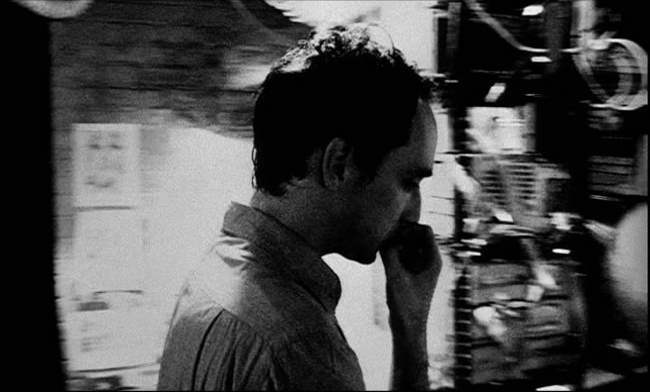
The Story: Max Cohen (played wonderfully by Sean Gullette) is a neurotic, genius mathematician who obsesses about trying to understand the stock market. He begins to think there is an underlying pattern that underlies the dynamics of the stock market – a pattern that can be explained in a 216 digit number. Max developeds an organic supercomputer that takes up the bulk of his apartment to further his search by developing tests and programs, but unfortunately, he still can’t find the answer. As his obsession deepens, he becomes tortured with headaches and nosebleeds.
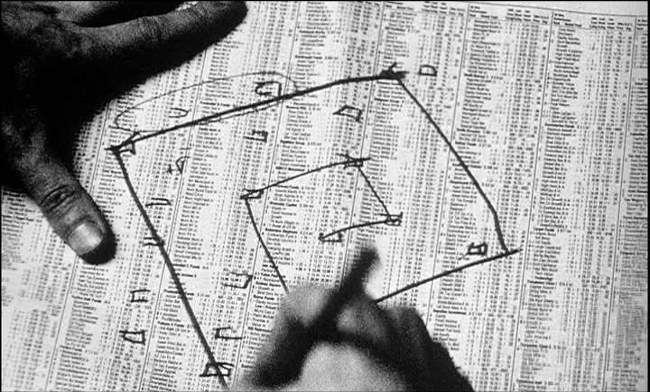
1. Mathematics is the language of nature
2. Everything around us can be represented and understood through numbers
3. If you graph the numbers of any system, patterns emerge. Therefore, there are patterns everywhere in nature. So what about the stock market…
My hypothesis, within the stock market there is a pattern, right in front of me…
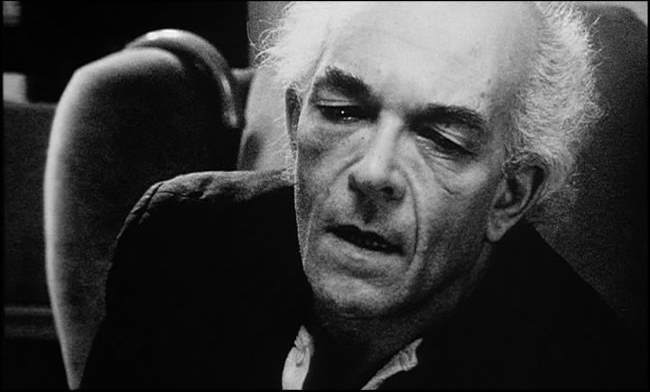
Max is paranoid in the extreme, and suspiciously assumes everyone is out to get him. Even his old teacher, Sol (Mark Margolis), comes under suspicion after cautioning Max to moderate his obsession. Max believes he is continually being followed (in fact he is). Finally, a Wall Street corporate representative named Marcy (Pamela Hart) offers him the use of a high-powered, secret chip to run his organic supercomputer – all she wants in return is insight into his results.
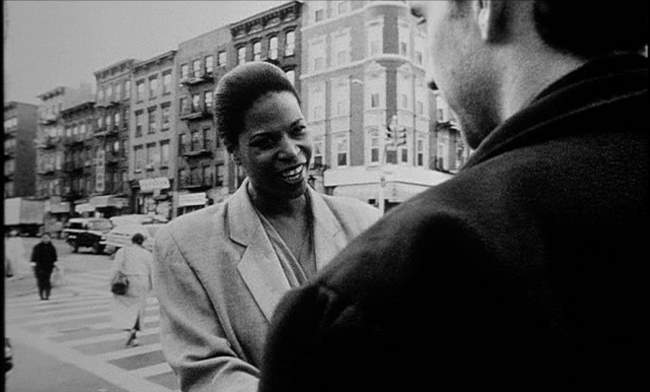
While getting coffee, Max meets a nice Hasidic Jew named Lenny (Ben Shenkman) who appears to have an interest in numerology. As Max gets to know him better, it turns out that Lenny is part of a group seeking God’s real name, which just happens to be a 216 digit number. This group believes that God has made Max his vessel, and in uncovering the secret of the stock market, Max will simultaneously be able to give them the key to salvation. As Max gets closer to finding the answer, it becomes clear that neither of these groups have Max’s best interest in mind - worse, they aren’t going to take “No” for an answer.
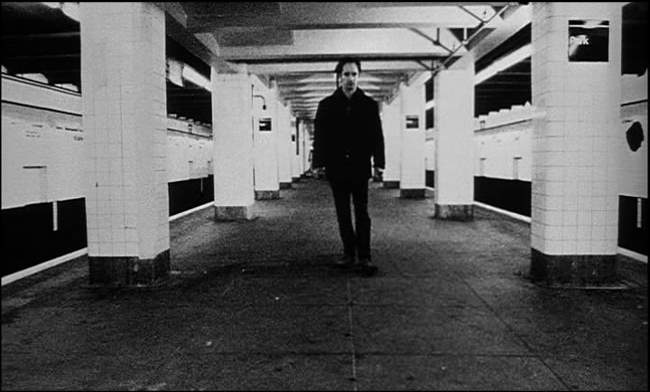
The Cinematography: Given that Aronofsky has so little to work with in terms of budget, its hard to poke too many holes here. The washed out feel serves to make the viewer feel as if they’ve been up as long as Max, with ten too many cups of coffee in their system. The grainy black & white visuals work for the most part, although often one is left with the idea that in experimenting to foster a frenetic feel, Aronofsky sometimes goes overboard. Case in point, the room spinning works wonderfully, but then is taken to annoying extremes. This overly artistic experimentation feel generally works wonderfully, but on occasion distracts more from the story and pacing than it adds.
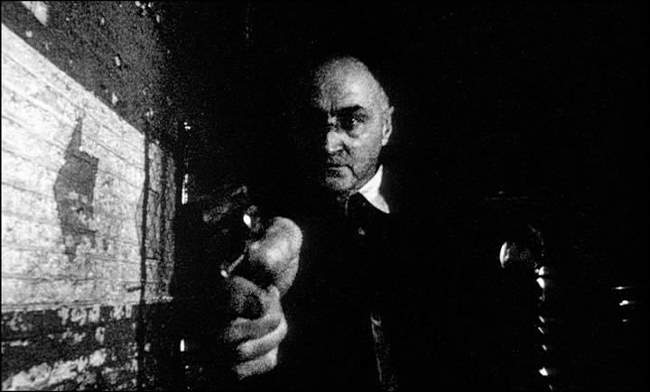
The Sound: As frenetic as the visuals are, these are matched by fast-paced, industrial rhythms and sound FX. The keyboard-laden soundtrack perfectly paces the story, which goes from contemplative moments to fast-paced, paranoid chases and fantasies. Tracks are continually reset to show a resetting of the thought process in the movie, and then spin out of control, again mimicking the transition in the scenes. Pi is one of those movies where the sound is almost as critical to the mood as the visuals itself.
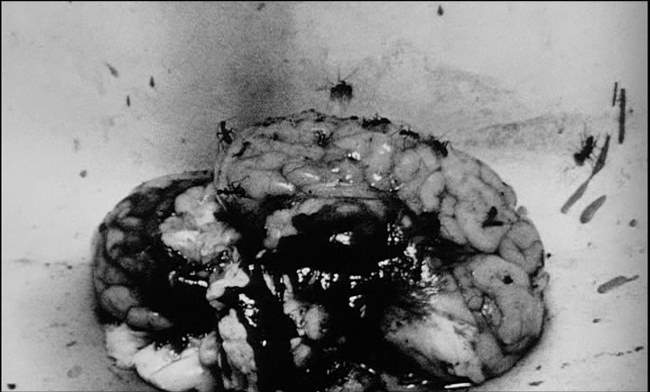
Genius With Insanity: In PI, Aronofsky explores the idea that genius often achieved in combination with insanity. Max Cohen’s mind is unique in that he is a master at number pattern assimilation. His obsession with a 216 digit number, which might be the key to understanding nature itself borders on both genius and insanity. Eventually Max starts to see his brain outside his body, sometimes covered with insects, crawling about. Max begins to imagine puncturing the mathematics portion of his brain to end the obsession. Instead, he continues on his quest. In essence, Max needs to become insane in order to truly tap into his genius.

Converging Knowledge Domains – Economics And Religion: One of the interesting facets of Pi is the degree to which overlapping knowledge domains are explored. In examining whether there is a 216 digit number, of which its meaning and syntax can explain both the stock market and God’s will, Aronofsky juxtaposes the meaning of humanity (God’s will) with society’s insane drive toward wealth creation. Worse, Aronofsky’s setting is a world in which our social context – our human-ness has devolved into a paranoid, lonely landscape, where socialization is no longer about friendship – it’s about survival of the fittest. Max is first and foremost alone. Everyone he interacts with has a nefarious motive. As we move toward a world that is divorced from humanity, one can’t help but wonder what our pattern-finding minds will devise. Aronofsky ‘s answer is clear – finding the stairway to heaven now becomes a by-product of seeking to greedily game the cornerstone of our society’s tally of winners and losers – the stock market.
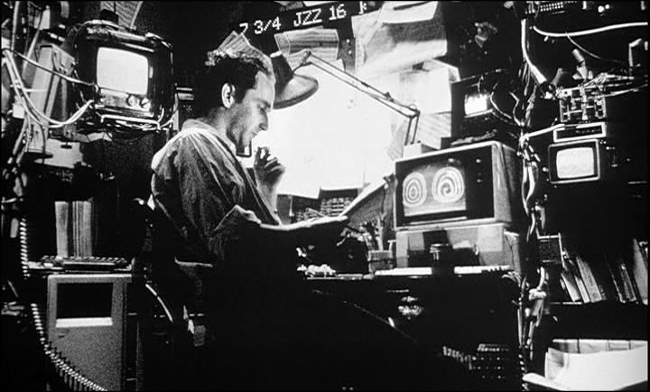
Is Max’s Computer Self-Aware? I totally missed this connection, but Textpundit below makes an excellent case for this:
Okay, I get what you mean when you say “organic”… but I mean actually a small bit “organic”, as in animal. Remember when the computer comes up with the number the first time and then shorts out the processor? When Max goes to change the CPU out, he finds some kind of gooey, organic matter…almost like scrambled brain matter or something similar.
That’s where I came up with the idea that the computer became self-aware (even if only for a split second) when it found the number.
I need to watch this again, but the “gooey” matter that Max keeps finding seems clearly organic in nature. So either this is part of his paranoid delusions (like the external brain), or in fact his computer becomes self-aware. If so, it’s his computer, not Max, who is truly God’s vessel. This actually makes the movie quite a bit more interesting, especially when coupled with the idea that the “vessel” needs to be pure. Clearly no human fits this description, as Max points out to the Rabbi. But Max’s response, “It came to me!” is just as flawed - perhaps it came to his now self-aware computer, who is pure. I’m beginning to think I was just a bit slow in grasping this - did anyone else get this interpretation?
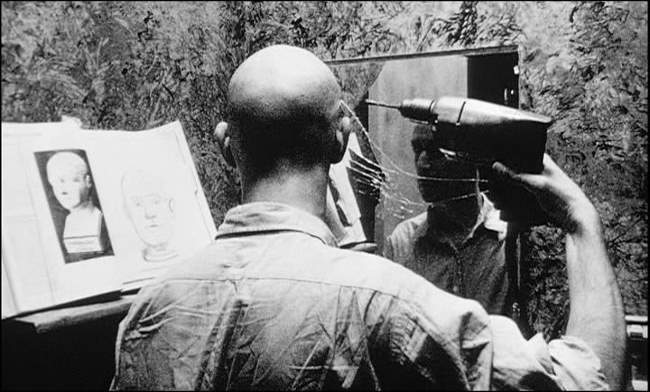
The Bottom Line: The teaming of Aronofsky with Sean Gullette is a terrific one, as they almost seem made for each other. The overall feeling of Pi, while not enjoyable to sit through is certainly very memorable. The ideas are interesting, but it’s the wonderful acting, immersive mood and frenetic pacing which really sell the film. I must admit though, the first time I saw Pi (years ago, before I created this site) I wasn’t as enamored with it as I am now. It really took a second viewing for me to warm up to – it grows on you.
Movie Review By: Mr. Roboto
Year: 1992
Directed by: Phil Alden Robinson
Written by: Phil Alden Robinson, Lawrence Lasker, Walter F. Parkes
IMDB Reference
Degree of Cyberpunk Visuals: Low
Correlation to Cyberpunk Themes: Medium
Key Cast Members:
- Martin Bishop (”Marty”): Robert Redford
- Donald Crease: Sidney Poitier
- Erwin Emory (”Whistler”): David Strathairn
- “Mother”: Dan Akroyd
- Carl Arbegast: River Phoenix
- Liz: Mary McDonnell
- Cosmo: Ben Kingsley
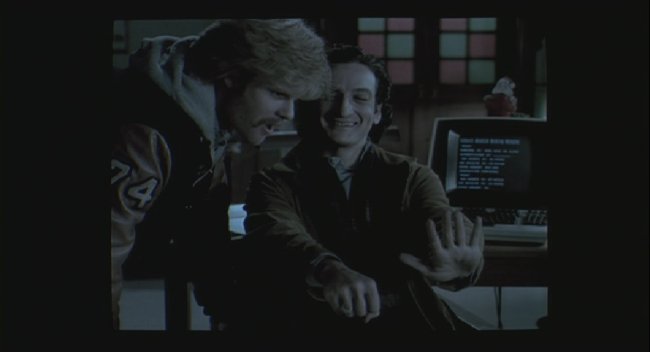
December 1969: Marty and Cosmo just helped the Republicans make a donation to the Black Panthers. Right on!
OVERVIEW: Martin Bryce is a fugitive since December 1969 when he left for pizza while his friend, Cosmo, was arrested for their hacking activities. Now living as Martin Bishop, he leads a “tiger team” that tests security systems. Two men claiming to be from the NSA want to hire Marty’s team to retrieve a “black box” developed by a brilliant mathematician for a project called “SETEC Astronomy.” They succeed in retrieving the box, but when they discover what it is, that’s when the real danger begins…
Note: Not an actual screen shot. Animation of key Scrabble moment in movie.

Remember: When playing Scrabble on Monterey’s Coast, keep score on My Socrates Note or you’ll end up with Cootys Rat Semen!
Sneakers is an intellectual cyber-caper movie that features an all-star cast with a slick production. There’s little question about this being a great movie to watch…
… But is it cyberpunk?: Some might question whether Sneakers qualifies as a cyberpunk movie. Other cyberpunk sites do list it as such, but does it make the grade here? Let’s compare it to SFAM’s idea of what makes a movie cyberpunk:
- Negative impact of technology on humanity: The “black box” is capable of breaking the most secure encryption codes without the need for a key. Whoever has this device can essentially read any e-mail, site, or whatever they want, without needing a decryption key. Sound pretty negative to me.
- Fusion of man and machine: In literal terms, no such fusion occurs here. The closest would be Whistler using his braille terminal, though one might say that Marty’s team does work like a well-tuned machine.
- Corporate control over society: Things are a bit hazy here. While there’s no such control apparent, one can imagine what the wrong people can do with the “black box.”
- Story focuses on the underground: Mary and Cosmo are hackers from the 60s. Cosmo works with organized crime (”Don’t kid yourself. It’s not that organized.”), and Marty’s team is mostly made from people who got into trouble with some type of technical activity.
- Ubiquitous access to information: The ability to decrypt and read any site or message. ‘Nuff said.
- Visuals and style: Being set in modern San Francisco (circa 1992) makes it impossible to depict a near future, but there are scenes where single colors and contrasting schemes are apparent: The red brick of the team’s office during the Scrabble scene, the darkness of Marty’s ride in the trunk of a car, Cosmo’s bluish office with the bright white “soundproof” room.
The movie itself has an intelligent style that often make viewers think about the consequences of the “black box” decrypter, politics, privacy, and the role of the NSA.
The Bottom Line: This is definitely one that needs to be in your collection alongside WarGames. It’s a fun, intelligent, and even humorous (sometimes darkly humorous) adventure into our privacy at stake. As to whether it can be called cyberpunk…
WHO CARES?
You’ll definitely like watching Sneakers and trying to decide for yourself
And while you watch this gem, keep this almost Matrix-like observation in mind:
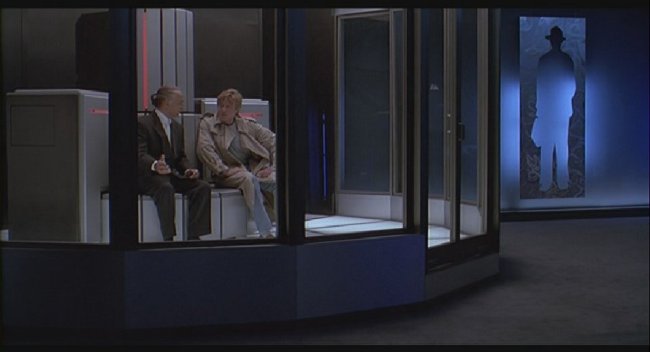
“… I learned that everything in this world, including money, operates not on reality. — But the perception of reality.”
Page 2: More Screencaps –>>
Movie Review By: SFAM
Year: 1997
Directed by: Andrew Niccol
Written by: Andrew Niccol
IMDB Reference
Degree of Cyberpunk Visuals: Medium
Correlation to Cyberpunk Themes: High
Key Cast Members:
Vincent Freeman: Ethan Hawke
Jerome Eugene Morrow: Jude Law
Irene Cassini: Uma Thurman
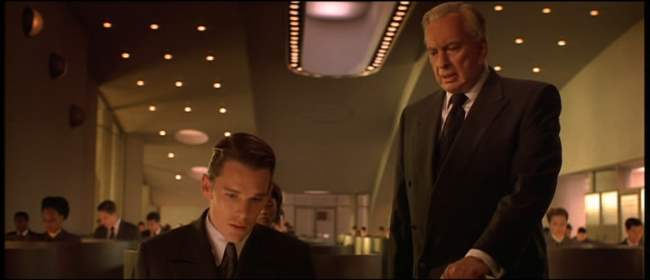
Overview: Director Andrew Niccol explores the potential horrors of genetic engineering in Gattaca. Originally seen as a flop, taking in only 12 million on a 36 million dollar budget, Gattaca has developed a loyal following from cable and DVD viewings. Whether or not people find this movie enjoyable or believable, virtually everyone agrees that Gattaca is quality film. Viewers will definitely notice a well paced movie that’s wonderfully acted in artfully composed scenes.
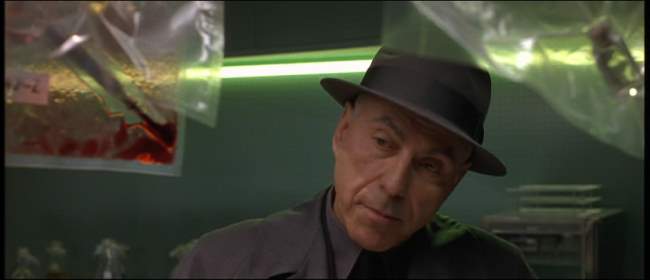
The Setting: In an unspecified near future time frame, genetic engineering has altered the course of society. Genetic engineering is employed to remove all major defects when conceiving. Upon birth, each new-born baby is given a Genetic Quotient (G.Q.) that details their potential risk areas, including heart issues and susceptibility to diseases. Some couples still ignore the genetic engineering of children and instead go for a “faith birth” – one where potential defects in the baby are left to chance. Unfortunately, these “faith” children now grow up in a world where their genetic pedigree significantly reduces their opportunities. A surveillance society is now in place where people are divided into having either “valid” and “in-valid” status. Highly sought after jobs are only available to those with “valid” status, while “in-valids” are left to handle the menial tasks of society.
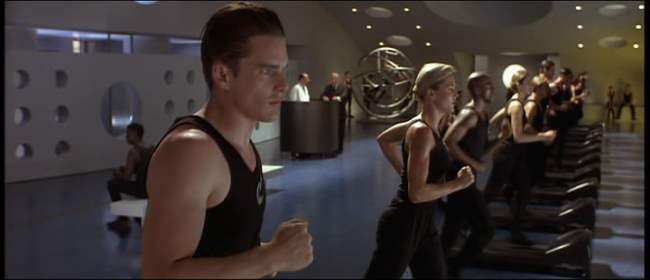
Ethan Hawke plays a flawed “faith birth” named Vincent Freeman who dreams of becoming an astronaut. Vincent is particularly flawed, and is predicted to have a 99% chance of heart failure by age 30. All but the most menial jobs are out of reach for “de-gene-erits” like Vincent, and he is told by both is parents and his genetically engineered brother to lower his expectations. But Vincent decides to defy the odds. Vincent seeks out shady characters in the underclass who put him in contact with wheel chair-bound Jerome (Jude Law), a person with an almost perfect GQ score, who broke his back in a car accident. Jerome agrees to give Vincent urine and blood samples so that he can assume Jerome’s identity and bypass the security measures in place at Gattaca, the huge aerospace corporation.
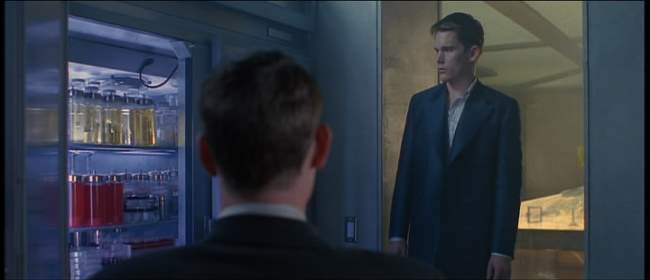
Vincent succeeds in fooling Gattaca personnel with the urine and blood samples, and by almost neurotically ensuring that any genetic tissue of his will not be left behind. He scrubs his body daily to remove excess skin cells or loose hairs, and constantly cleans his office space and keyboard to ensure there is no material left behind other than planted samples from Jerome. Due to his immense personal drive, Vincent quickly climbs the ranks of the organization. He is put on a project to design a year-long flight to one of Saturn’s moons.
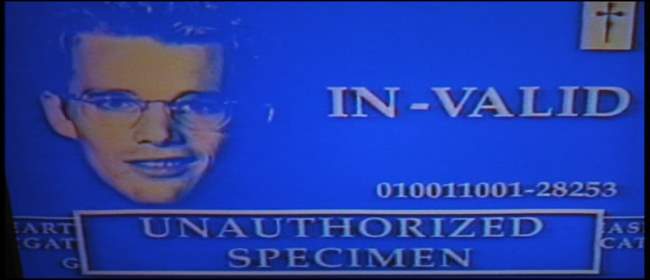
Vincent’s dreams are almost coming true, but just as quickly his dreams are jeopardized when the lead flight director is horribly murdered – unfortunately the investigation has turned up one of Vincent’s “in-valid” eyelashes. Worse, his brother Anton is heading up the investigation. Complicating matters further, Vincent has fallen for a fellow Gattaca employee named Irene (Uma Thurman). Irene’s GQ is not good enough for flight, and has accepted her lesser standing in society. Ethan must escape the investigation while still keeping his astronaut and love life dreams alive.
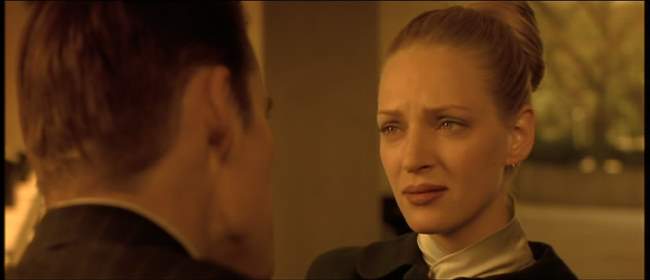
The Acting: Gattaca boasts a terrific cast in which all key roles are wonderfully delivered. Ethan Hawke provides us with a terrific flawed but inspired faith child. Jude Law is just as good as the crippled GQ has-been, and Uma Thurman performs solidly in a supporting role as the love interest who has given up hope for fulfilling her dreams. The rest of the cast is also solid, including Alan Arkin as a beat cop, and William Lee Scott as Vincent’s brother. Along with solid pacing, the quality of the acting allow us to overlook some of the more problematic aspects of the story.

The Visuals: Gattaca goes for an understated, high-tech view of the future, where we are only treated to the higher echelons of society. Director Andrew Niccol plays with a number of oppressive color schemes to give us a dystopic vibe. Yellows and blacks are constantly employed, as are dull blue-grays to provide us a sense of hopelessness and inevitability. Greens and sleek, shiny charcoal grays are employed to convey the high-tech nature of society. Niccol and Cinematographer Slawomir Idziak consistently provide us with well composed shots and artistic visuals and set pieces that take in a range of lighting and shadows effects.
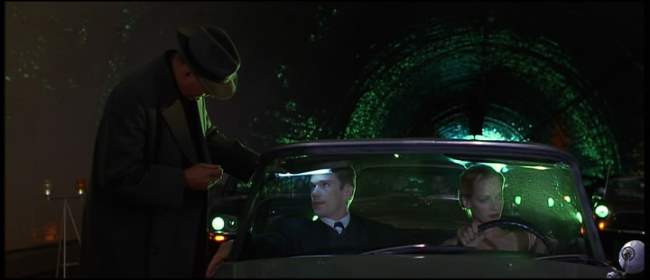
Surveillance Society Through Genetic Profiling: The vision of a domineering surveillance society we see in Gattaca may be more relevant now than when it was released in 1997. In thinking through a variety of policy options, the United States is currently debating the trade-offs between public safety and personal privacy. Worse, the technology surrounding our personal genetic code is right around the corner that will give insurance companies information on predilections we have toward certain diseases. It is hardly a stretch to imagine corporations and insurance companies engaging in genetic profiling within the next ten years or so. In that sense, Gattaca cuts to the heart of the issue – even though percentages may suggest clear issues with the majority of a population, there will still be outliers like Vincent. Gattaca tells us that personal drive can still overcome genetic superiority.
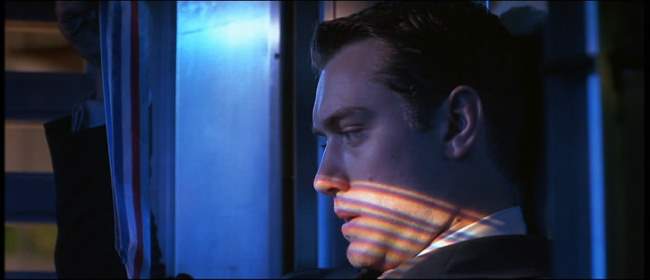
Genetics Is Overplayed: In many ways, Gattaca is a one trick pony in that it examines a world where genetic profiling drives virtually every aspect of society. While the vision is motivating, we are left wondering why extreme advances in genetics don’t lead to improvements in medical care. For instance, a prediction upon birth that a heart has a 99% of failure by age 30 is based on an assumption medical treatments will remain static. For the viewer to buy this vision of the future, we must believe that society has given up on the long-standing notion that technology can cure all ills. On a lesser scale, one wonders why a corporation as powerful as the Gattaca Corporation cannot figure a more streamlined method of ensuring the loyalty of their employees – one wonders who any work is ever done considering the employees seem to spent a significant amount of time verifying their identity and drug free status through the daily gauntlet of surveillance testing.
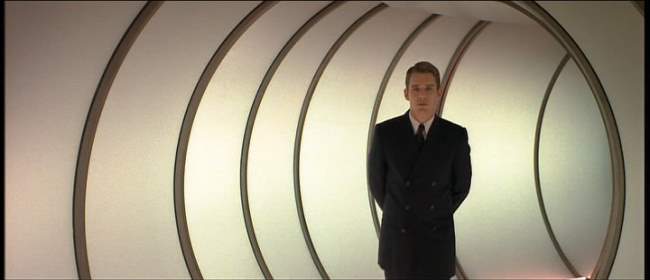
The Bottom Line: Gattaca is a very well made film that provides us a valuable cautionary tale into how genetic engineering abuses could lead to significant societal maladies. The pacing, acting and cinematography are all of consistently high quality. That said, the world of Gattaca isn’t as coherent as I would have liked. We get no sense of the political implications of genetic profiling, nor do we see any innovations other than genetic engineering. In this sense the future setting is perhaps more simplistic than was necessary. Additionally, some of the plot points seem over-contrived. The last week of Vincent’s life prior to launch has too much going on (a new love interest, a murder investigation headed up by his brother, issues with Jerome), and there was probably a bit of overkill on the sentimental ending. That said, Gattaca is a great flick, and very much deserves a viewing.
Movie Review By: SFAM
Year: 2006
Directed by: Christian Volckman
Written by: Alexandre de La Patellière, Mathieu Delaporte, et al.
IMDB Reference
Degree of Cyberpunk Visuals: Very High
Correlation to Cyberpunk Themes: Medium
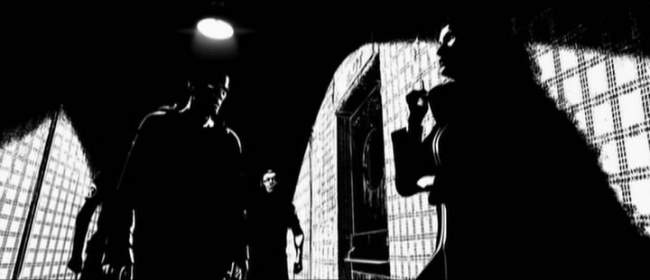
Overview – Good luck in finding a copy! Once upon a time, Renaissance was one of my most anticipated movies of 2006. Originally released in France on March 15th, I eagerly awaited its September release in the US. My anticipation was heightened in that I was even contacted by Miramax representatives as part of a pre-hype blitz. So imagine my surprise when its release in the US only comprised a few select cities – unfortunately my city didn’t make the cut (thanks Miramax!). Similar to so many other good, but foreign science fiction and fantasy flicks, instead of getting a nice theatrical viewing, I was yet again forced wait and then later buy an import (or pirated – sometimes you just aren’t sure) DVD off of eBay. If you are in the US and are interested in seeing Renaissance, chances are you’re in the same boat. One would have hoped that a movie as visually stunning as Renaissance would have been at least able to quality for a DVD release, but clearly something larger is going on here as many other foreign genre films are in the same boat.
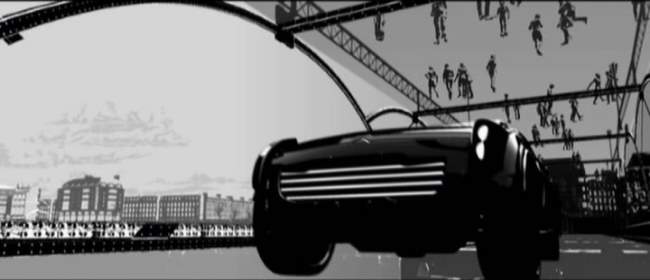
The Setting: In the year 2054, mega-corporations are all-powerful, with tentacles in all aspects of life. The divisions between rich (megacorps) and poor are greater than ever. Paris has grown in layers, with high-tech buildings pushing every further into the sky. Although the city is sleek and stylish, most people live a pathetic existence. In Paris, the Avalon Corporation rules the cityscapes. The police force is not immune from their pressures, and often become their lackeys.
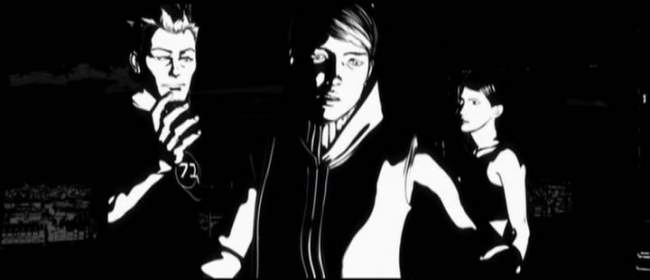
The Story: When a promising young biogeneticist named Ilona (voiced by Romala Garai) from the Avalon Corporation is kidnapped, detective Barthélémy Karas (Daniel Craig) and his team are brought in to investigate. As Karas interviews all the key players, it becomes clear that this isn’t a simple missing person case, as the details of the disappearance become increasingly more bizarre and complicated. The Avalon corporation president, Dellenback (Jonathan Pryce), not known for his loyalty to his workers, is extremely interested in her return. Ilona’s bioengineering mentor has a strange past, and stopped doing research after an accident from 2006. Karas befriends Ilona’s older sister, Bislane (Catherine McCormack), who tells of a stolen book.
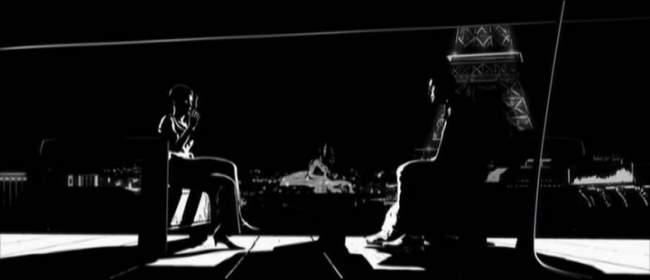
Similar to Howard Hawks’ “The Big Sleep” (1946), Karas spirals back and forth between the key players as more clues are provided. Karas uncovers a darker side of the Avalon Corporation, and of Ilona’s mentor, Dellenback. Furthermore, it appears that the secret to immortality has been discovered, and is tied to Ilona herself. As Karas and Bislane continue searching for Ilona, the list of enemies grows. The key players are getting offed, Karas is booted from the force, and is now in fear of his life. Worse, they are discovering that humanity itself may be at risk if Ilona is found.
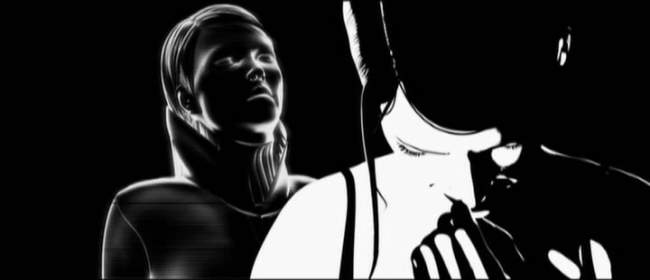
The Characters: It’s not a stretch to say that virtually every character in Renaissance comes “cookie cutter” from the old noir movies, with a nice slice of traditional cyberpunk thrown in the mix. From the honest but jaded crusty cop with a soft spot to the megalomaniac mega-corporation leader, to the shady friend the cop goes to when he needs a favor to the femme fatale; don’t expect freshness, because it isn’t coming. Like the old noirs, everyone in Renaissance is flawed; everyone is gray – which does make for an interesting contrast when transposed on such stark black and white animation.
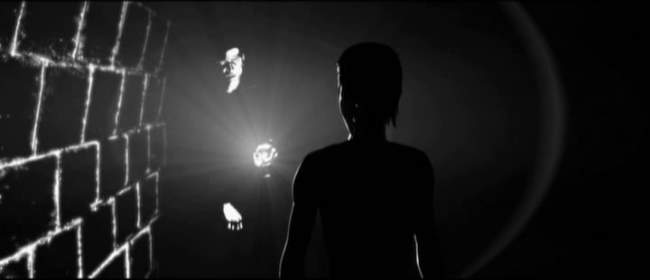
The Atmosphere: While the story falls short, the look of Renaissance fully original and is flat-out amazing. If Renaissance is best described as style over substance, the style really comes STRONG to the party. Stark black and whites dominate virtually every shot. Shadows are in abundance, and usually highlight the main action points. Gray is used sparingly, and is usually applied to change the mood of the scene. To its credit, Volckman succeeds at creating a near-future world that is deeply flawed but not overly futuristic. The cityscapes are incredibly detailed, and give the impression that there are always a bevy of interesting happenings occurring. A transparent glass-like substance is now used to make walkways above and below the roads – this more than anything creates a sleek, near-future ambience. The stark black and white look of Renaissance works well both in the daylight and evening shots, both having shadows prominently placed in virtually every frame.
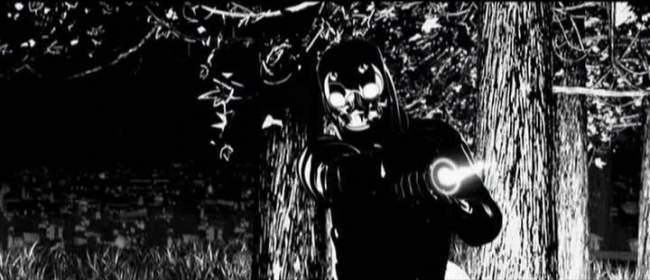
Traditional cyberpunk conventions are often applied, including huge billboards of beautiful women that extol the virtues of the Avalon Corporation. Avalon fills the role of the dominating mega-corporation that owns and controls virtually everything in Paris. Nothing is beyond their grasp. The police are on their payroll, and the entire city appears to be under surveillance. Immortality, derived through advances in bioengineering (initially undertaken by a Japanese scientist) is the dominating technology intended to challenge God’s position over humanity.

Similarities with Sin City: Volckman stated he was interested in creating a visual feel similar to what one might get when looking at a painting. In terms of what was produced, yes, the look is definitely similar, but Renaissance is not copying Sin City. Although Sin City came out first, Renaissance started its production far before Sin City. In terms of look, Renaissance really does match very closely with the Sin City graphic novels – more so than Sin City in fact. But while it also is a neo-noir, the dialogue and mood of Renaissance is far more like a corporate espionage version of a standard 40s detective noir (think “The Big Sleep” with corporations instead of the mob), whereas Sin City had more of a hyper-real, over-the-top neo-noir feel.
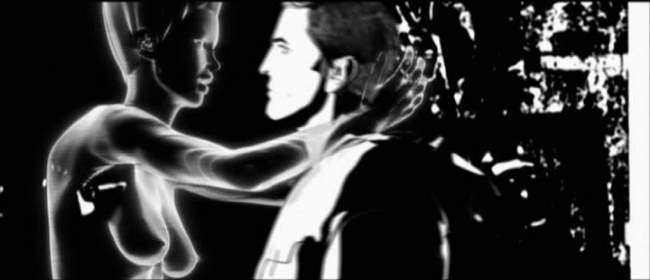
The Animation: Using an innovative motion-capture to rotoscope approach, where 24 cameras are used when shooting the actors, Volckman was able to work on the framing and viewpoint well after the shoot was complete, and then paint on the black and white animation. Unlike Linklater’s rotoscoping, where the actors’ faces and body appear to be constantly shifting, the level of precision used in Renaissance is significantly higher. When moving, the sprite’s actions are incredibly human-looking. There is a slight lag though when they first take action – a noticeable lag that’s slower than you would expect a person’s actions to be.
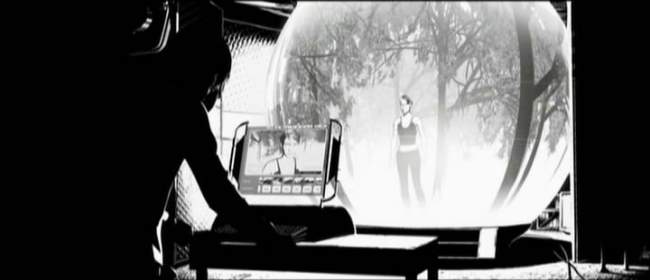
The Technology: While the basic story for Renaissance is straight cyberpunk neo-noir, the technology options provided are numerous and fairly interesting. Most visually arresting was the Holodeck sphere prison where Ilona is kept. Karas had a very advanced cybernetic eye implant that allowed him to identify people through solid objects – it also was able to be hacked by Avalon, the Mega-corporation. Computers are slick, now often just the size of a pen with a virtual display that arises upon command. Biotechnological modifications are in vogue, although not at the level of Ghost in the Shell. Similar to Motoko’s invisibility suit, the goons at Avalon have similar suits, although they look more like the soldiers in Jin-Roh than they do the hawt, naked Motoko. Holograms are now used in combination with pictures to remember people and events – in some cases, holograms interact with their human counterparts.
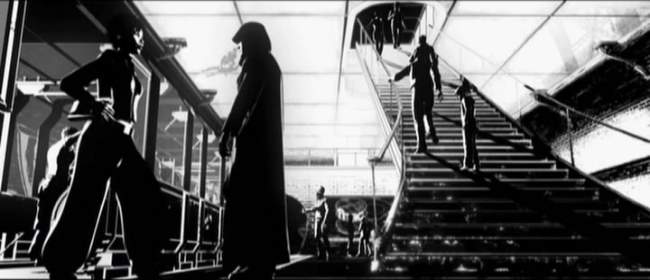
Do you Want to Live Forever? One thesis of Renaissance is the notion that immortality, if invented, would destroy humanity. Not a lot of backing is provided for this idea, but the idea put forward is that this irrevocable change in the hands of a mega-corporation would provide a method of control so powerful that society would no longer function. This is all the more interesting in that some are predicting that humanity will have the equivalent of immortality within the next 50 years. If this comes to pass, will the possibility of immortality be distributed evenly or will this be a tool of domination similar to in Renaissance?
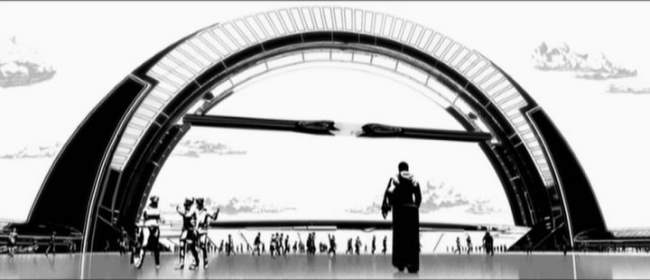
The Bottom Line: Although the story and characters are not original, the animation and overall cinematography is both innovative and outstanding, and should not be missed. There is truly something unique in the look here that you just won’t find anywhere else. The voice and motion acting are more than passable and Nicholas Dodd’s score provides a wonderful combination of a 007 espionage flick with the haunting eeriness of the score from Stargate. As icing on the cake, the science, technology and architecture exhibited in Renaissance will make you think. It may be hard to find, but it’s well worth the time spent looking for it.
Page 2, More Screencaps–>
~See movies similar to this one~
Movie Review By: SFAM
Year: 2002
Directed by: Kurt Wimmer
Written by: Kurt Wimmer
IMDB Reference
Degree of Cyberpunk Visuals: High
Correlation to Cyberpunk Themes: Medium
Key Cast Members:
Cleric John Preston: Christian Bale
Dupont: Angus Macfadyen
Errol Partridge: Sean Bean
Brandt: Taye Diggs
Jürgen: William Fichtner
Mary O’Brien: Emily Watson
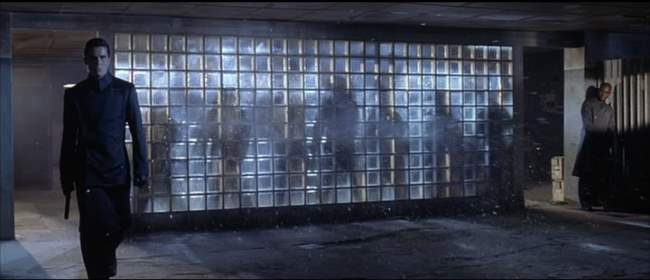
Overview: Equilibrium is one of those movies that most everyone who knows of it has only seen it on DVD. Essentially thrown away by its studio, Equilibrium, created for a budget just over 20 million was given no dollars for marketing and made less than a million at the box office. But don’t let that sway you into thinking this movie is a piece of trash. Equilibrium has become a cult DVD hit. Made in Eastern Germany portion of Berlin, Equilibrium looks lots more substantial than the 20 million that went into it. Due to some terrific location choices, Equilibrium shines with a polish of a movie made for at least twice that budget. This, plus high quality acting and at least a modicum of interesting thought raise Equilibrium up from the pop-FX action-fest that it otherwise might have become.
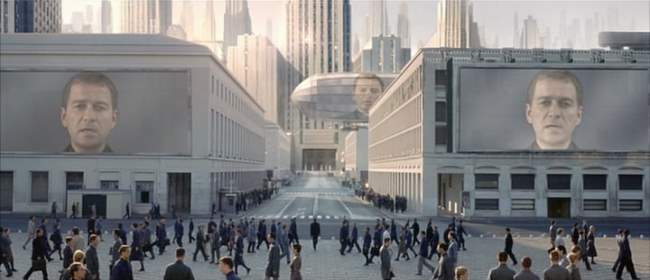
The Setting: Set sometime in the 21st century, after a massive nuclear war has wiped out the majority of the human race, a 1984 style society has emerged after a method of full population control was discovered. The entire population is now given a daily dose of a drug called of Prozium. Prozium removes all semblances of emotion, and leaves the populace docile and controlled. Exhibiting emotion is now considered the greatest of all crimes, and is punishable by death. The all-knowing, all-controlling “Father” has constructed a group of supra-police called “clerics” who spend their time seeking out “sense offenders” and burning all remnants of the old way.
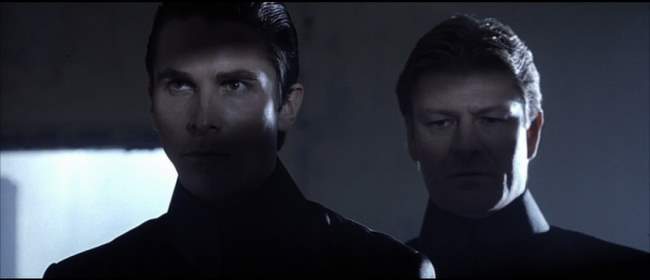
The Story: Cleric John Preston (starring Christian Bale) is among the best cleric enforcers. Along with his partner, Errol Partridge (Sean Bean), they spend their days burning heretical artifacts like the Mona Lisa and bringing sense offenders in for processing – a euphemism for baking people in a large oven. Unfortunately, Partridge has begun to have doubts about society, and has apparently stopped taking the drug. After Preston finds out and kills him, Partridge’s final thoughts compel Preston to revisit his own personal history in which he showed no emotions as his wife was burned for sense making. Preston begins to question the intense surveillance society.
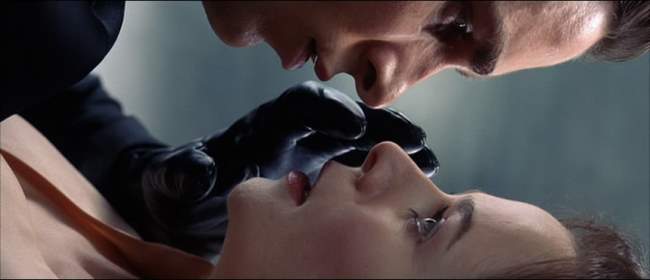
In tracking down Partridge’s lover (Emily Watson), Preston’s world finally crumbles. Now he realizes he has presided over the destruction of humanity, and can no longer continue. Unfortunately, Dupont (Angus Macfadyen), the mouthpiece of the Father and leader of the Clerics has asked Preston to infiltrate the remainder of the resistance in order to crush them once and for all. But Preston is actually approached by the resistance leader, Jürgen (William Fichtner) who has noticed his recent spate of emotion. While Preston is still conflicted, Jürgen tries to enlist Preston in destroying the Father. Even worse, Preston’s ambitious new partner, Brandt (Taye Diggs) strongly suspects Preston of becoming a sense offender.
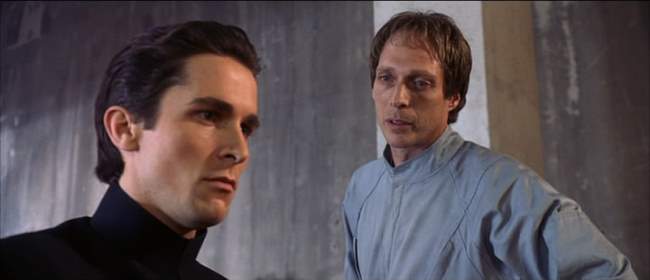
The Acting: The acting in Equilibrium is top notch. For my money, the best performance is turned in by Sean Bean, who, while only on screen for a brief time, really hammers home the essence of the message Equilibrium is conveying. But truly, all the main cast is terrific. Bale does a very good job in going through a conversion in losing his faith, while Fichtner, Macfadyen, Diggs and Watson all really add real believability to a somewhat forced story. Truly, the acting sets Equilibrium above a better than average genre movie to something really worth watching.
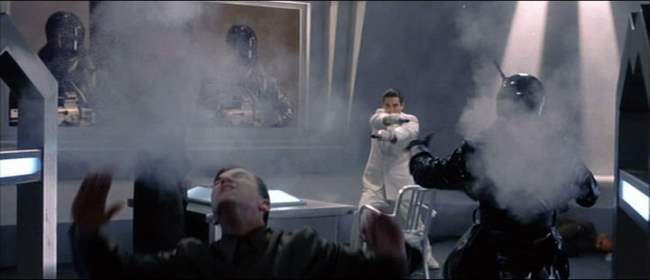
The Action - GunKata: Gunkata is Kurt Wimmer’s newly invented martial art – gun combat in close quarters. The idea is that body positioning and fluid movements, along with an intense understanding of one’s opponents’ most likely actions will allow the Gunkata master – Clerics, in Equilibrium – to be close to unstoppable. Many times in Equilibrium, Preston goes into a room LOADED of bad guys and wipes them all out. Does it look in the least realistic? Not at all, but it does look cool. The action sequences are hectic by design, but are always well planned out and executed. Even if you could care less about the message, if you like gun fighting, Equilibrium is for you!
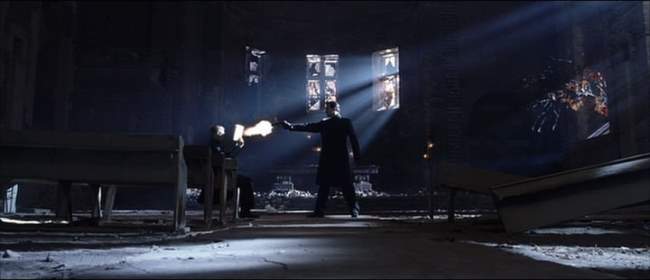
The Visuals: The color of the day for Equilibrium is black, gray and occasionally white. Virtually everything is in black with brief highlights. This makes the instances where other colors are used, such as Preston’s Bruce Lee white outfit near the end of the picture, or the yellow sunset as seeming enormously more significant than they normally would seem. The other dominant theme is squared off architecture. Everything here is comprised of right angles to emphasize the controlled, boxed-in feel of the society. Even worse, the only prominent place that a circle appears is the processing factory, where sense-offenders are burned. Wimmer uses his most excellent set selections to optimal effect. The Cinematography choices always go for high shadows and contrasts, and usually come from interesting angles and contexts. Without trying to resort to high-tech wizardry, the world Wimmer ultimately creates is believable and otherworldly.
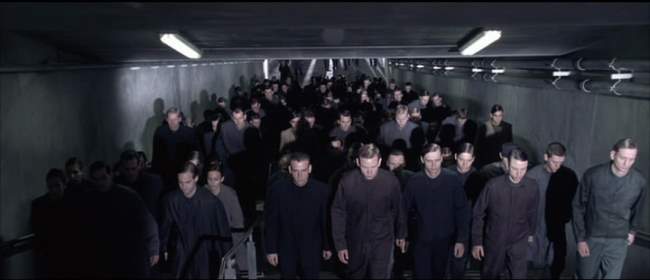
Centralized Control and the Surveillance Society: While the message is often obscured by the slick visuals and action sequences, Equilibrium’s basis is right out of the Metropolis, 1984 model. In looking at a situation where humanity has gone awry, the corrective procedure is one which divorces people from that which makes them human – their emotions. In this model, emotion control leads to thought control, which yields a smooth, functioning society. The warning is clear – if we move down a road that involves giving up our personal freedom, the danger is that we lose our technology. If I were to point out quibbles with this, the idea of the single, evil genius behind all of everything bad lessons the impact. The message conveyed is that society slowly made the choice to go this route – it would have been better to see remnants of that choice still guiding the society versus the simple “glorious leader” bad guy.
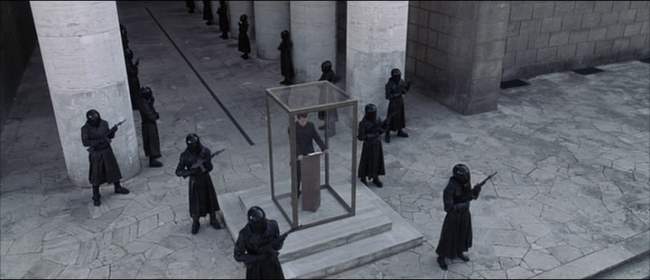
Is There Any Relevance to Today’s World? While only briefly mentioned by Sean Bean’s character, Partridge discusses the “trade off” that humanity made. In exchange for security and stability, they agreed to trade away their freewill. One gets the sense that this was a slow process at first, but which picked up dramatically once centralized control was present. While it’s a far stretch to imagine an emotion blocker being instituted, if we imagine freewill as a sliding scale, its clear that the debate between our personal freedoms and societal security measures are clashing right now. One can only imagine how much greater support the security side would be if in fact a nuclear conflict did break out. Unfortunately, this too is becoming far more likely – in 20 years, we can certainly envision that the number of groups and governments in possession of nuclear material will be far greater than today. The risk isn’t just that a small group of terrorists will use it. Unfortunately, pre-emption of conflict by larger countries could also lead to such a response. In short, as the concern for security and stability are greater, the pressure to impact personal freedoms will grow. If this isn’t a key ingredient for the creation of a cyberpunked world, I don’t know what would be.
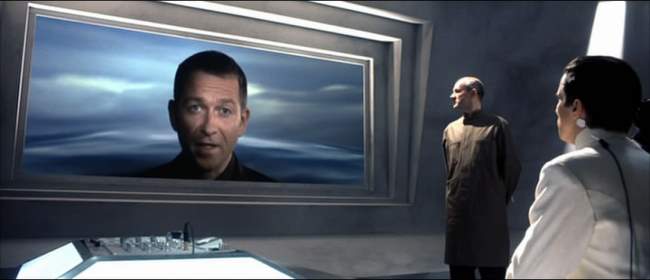
Is Equilibrium Cyberpunk? This is an open question at some level, but I’ve come down on the “yes” side (obviously, as its reviewed here) for three reasons. First, in Equilibrium, centralized control dominates all “above ground” communication, while the horizontal control is the domain of the rebels. We don’t really see any instances of an internet, but we know it exists in some form, based on the rebel leader Jürgen’s comments. The only true downer from a cyberpunk control standpoint is the book used to record contraband – gimme a break, Wimmer! The second reason is the drug, Prozium. The bio-engineered drugs serve as a dominating form of technology that serves to dehumanize society. Until we separate out “Biopunk” movies from Cyberpunk, Equilibrium belongs here. Thirdly, the visuals TRULY fit into a post-Matrix cyberpunk visual style. Without hearing a lick of dialogue, if you only saw the visuals, you might consider sticking Equilibrium into the cyberpunk bucket.
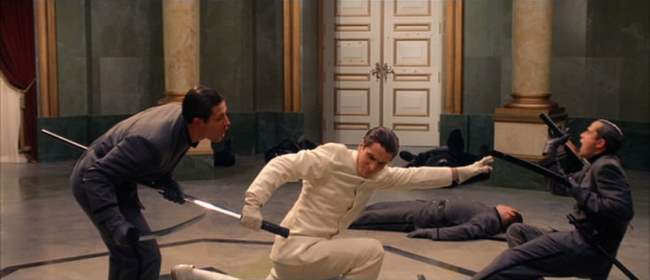
The Bottom Line: Equilibrium makes the most of its 20 million dollar budget. Truly, after watching it, most people are shocked to find out how little was spent on making Equilibrium. From an execution standpoint, everything fits like a sleeck black glove. From the well integrated and motivating score, to the high quality acting, to the even pacing, Equilibrium works to create a very believable mood. On top of this, Equilibrium’s action is hot shit! Wimmer’s creation of GunKata - a new martial arts for close-combat gunfighting is interesting and innovative. However, the story itself is still a stretch, as is the believability of the Gunkata. In the end though, this is really a minor quibble, as the end product is intelligent enough to cause you to ponder while engaging enough to keep you entertained.
~See movies similar to this one~
Movie Review By: SFAM
Year: 1987
Directed by: Katsuhito Akiyama, et. al.
Written by: Katsuhito Akiyama, et. al., Toshimichi Suzuki (story)
IMDB Reference
Degree of Cyberpunk Visuals: High
Correlation to Cyberpunk Themes: Medium
Key Cast Members:
Sylia Stingray (voice): Yoshiko Sakakibara
Priscilla S. Asagiri ‘Priss’ (voice): Kinuko Ômori
Linna Yamazaki (voice): Michie Tomizawa
Nene Romanova (voice)Akiko Hiramatsu: Akiko Hiramatsu
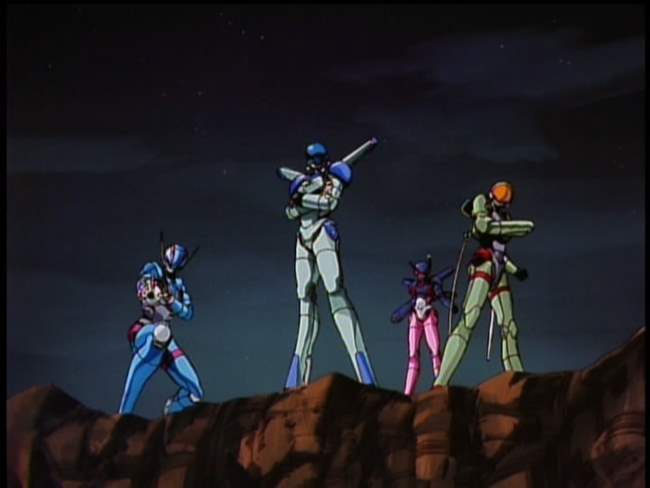
Overview: Bubblegum Crisis (BGC) is one of the all-time classics of cyberpunk animation and anime in general. With a team of hawt chicks kicking butt in cute mecha outfits, while upbeat songs play in the background, Bubblegum Crisis has developed a franchise and staying power that few titles can match. Quite a number of sequels have been created as a testament to this. BGC is influential in a number of ways. Not only has its character animation been widely imitated, BGC was one of the first shows brought over in the US with subtitles. Overall, while there are some dark moments, the original BGC is an action-oriented, mostly light-hearted affair.
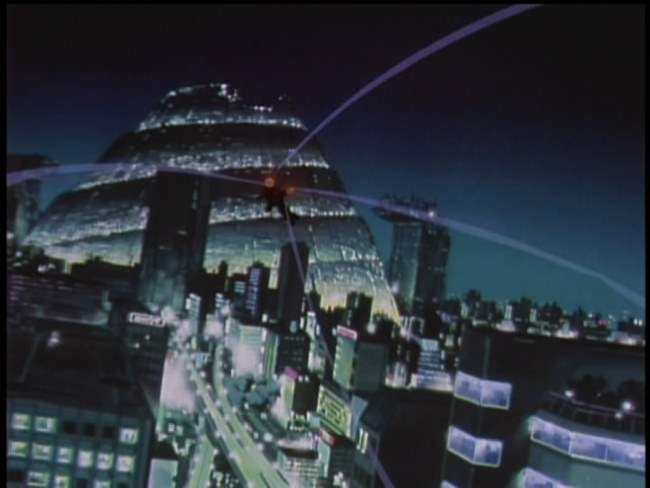
The Story: In 2025 an earthquake destroyed Tokyo. With the assistance of androids and robots created by the omnipresent and ever-powerful Genom corporation called boomers, Tokyo is rebuilt as Mega-Tokyo. Unfortunately, like Bladerunner, sometimes the boomers get out of line, often in fact. Boomers can appear human, but often this is just a fascade for a far more dangerous bio or mecha beast that can break-through the skin. In response to this danger, the authorities have created an under-funded agency called the AD Police, who’s primary mission is to handle boomer incidents. Unfortunately, often the boomers are too strong for the police to handle.
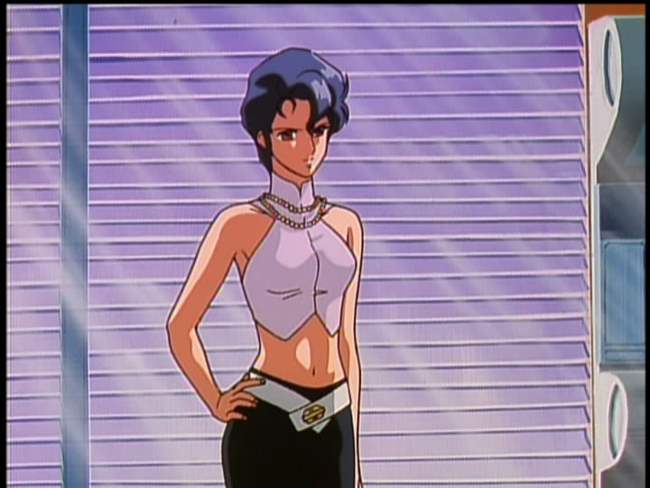
Enter the Knight Sabers. Headed up by Sylia Stingray, the billionaire daughter of the former Genom Corporation scientist who invented boomers, Sylia has advanced the research on her father’s mecha hard suits, and has recruited a team of three other hawt action chicks who, along with Sylia, comprise the Knight Sabers. All of them have secret identities. Priss is a pop singer, Nene is a hacker who works as a dispatcher at AD Police HQ, and Linna is an aerobics instructor. But all four of them have trained to become mercenaries extraordinaire in defense of boomer incidents.
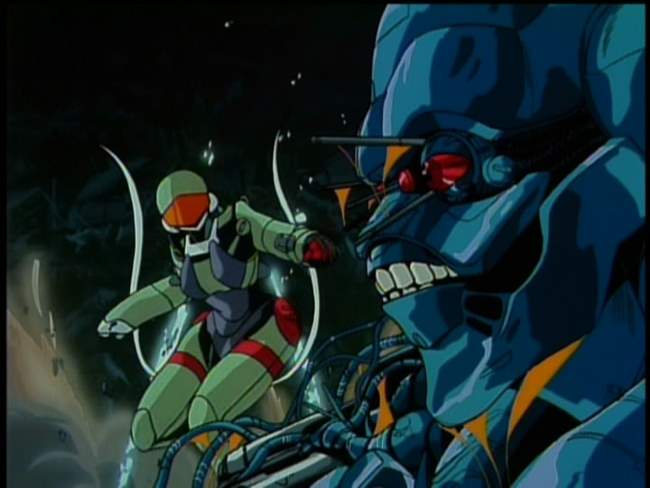
Unlike most OAVs, BGC is designed with each episode being as self-contained story. While many of the stories string together, there are no cliffhangers here. Some of the episodes have at least a modicum of intrigue, but generally, when it gets right down to it, the goal is for the knight riders to kick some boomer ass. Action dominates, which works considering the relatively short time allotted to each story (up to 50 minutes). As the series continues, most of the storylines deal with the Kight Sabers foiling attempts by the Genom corporation to secure even more power. A few of the episodes have complex storylines, but the majority are straightforward, with evil genius types (boomer or human) directing boomer machines who create death and destruction.
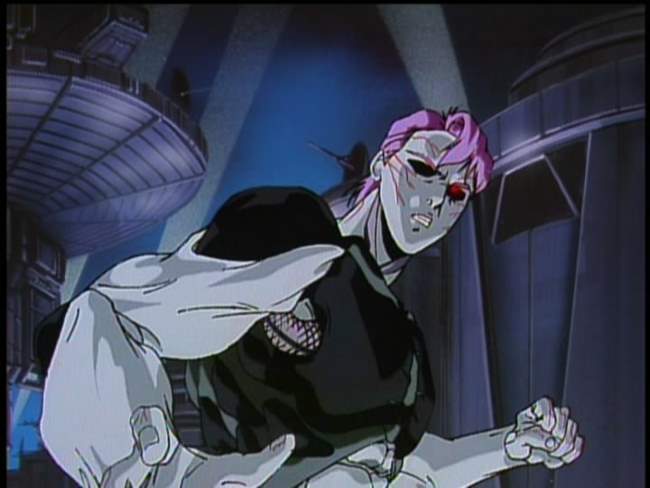
For me, my favorite episode is Episode #5, where a two unique bio-based sexroid boomers who need blood for sustenance escape from escape Genaros, the SDPC’s orbital supply station for humanity’s moonbases, and make their way to Mega-Tokyo. The episode is far more complex than most, and touches on similar issues to Blade Runner, in that these Boomers just want to be free to live. Most of the boomers in BGC (other than the major villains) don’t really exhibit any form of sentience, but the ones in this episode (and the continuation in #6) are sentient and multidimensional.
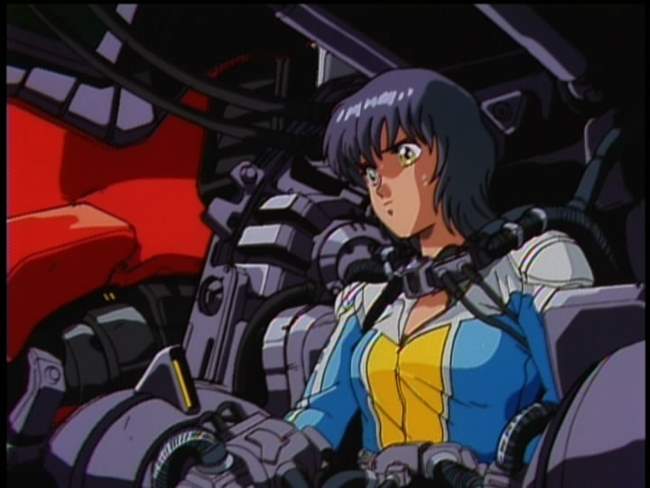
Influential Visuals: Along with Akira, BGC animation has been very influential in transforming anime to the popular style we see today. Characters with overly large eyes and the familiar facial styles are on display in BGC, as are a bevy of experimental looks and styles. The look of anime changed dramatically from the late 80s to the early nineties – BGC will always hold a place in history due to its influence on this change.
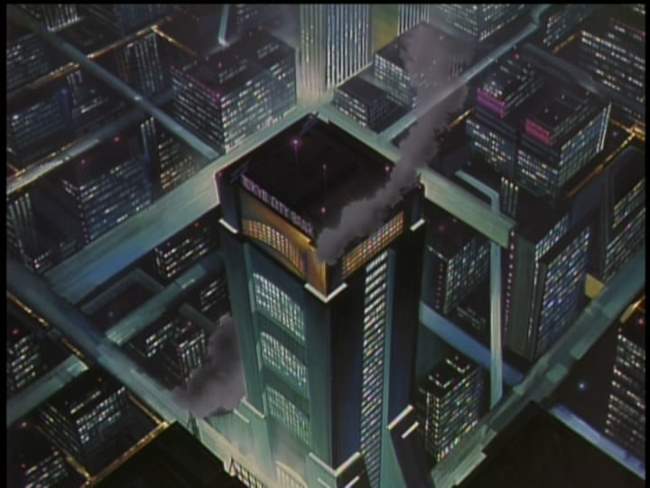
Mega-Tokyo: BGC took the Blade Runner city visuals and applied them to anime, which was then imitated by most of the shows that followed. The cityscapes are modern looking with a blue background, with various green and red highlights. Grays and blues are shown in abundance, with occasional orange and red daytime scenes. Most of the shots are from above, focusing on the overall city-scape, but there are a number of ultra-modern buildings including the Genom’s Tower (which looks like the Blade Runner Terrel Corporation building) and the AD Police building – same as Blade Runner as well.
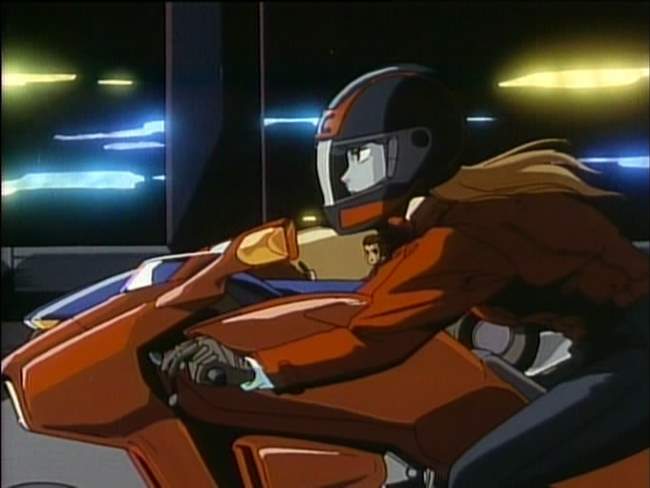
The Action: By far the best quality animation BGC brings is in their action sequences. While the rest of the series is really not very special, the action sequences are very well done. We get a variety of effects and perspectives that driving the relatively quick-pacing. In many of the scenes, the backgrounds show a variety of methods to enhance the speed and action. Often BGC engages in mecha-style battles (many of the bad-guy boomers are variations on mecha characters), but these are different from some in that the Kight Sabers are in nimble, tight-fitting suits, which increases the speed of the action.

The Music: Very few OVAs have music as recognizable as BCG. BGC is known for being one of the first (or at least one of the most recognized) to essentially embed music videos into their action sequences. The songs play a big part in Bubblegum Crises, with a large number of the action sequences and dramatic moments overlaid with song accompaniment. Almost twenty years later, this innovation has blossomed and morphed into what we see with FLCL for instance, where entire sequences are purely videos intertwined with the story.
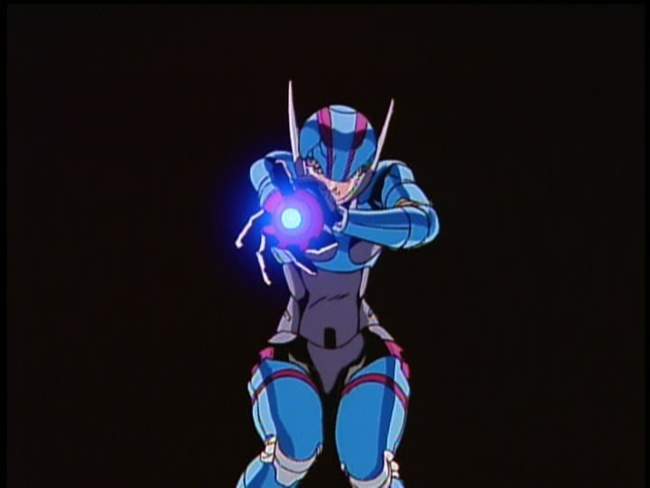
The Bottom Line : While I’m generally not too excited about mecha anime (this is purely a preference on my part, and not a knock on mecha), I find BGC quite enjoyable. BGC is more like an earlier version of GITS SAC in that the focus is action first, and philosophy second. While a few episodes do explore what it means to be human, in all but a few cases, this is usually done in the context of a fairly light plot and intense action. Perhaps the philosophical aspects would have been highlighted had the series continued, but for legal reasons, BGC was cut short at only eight episodes. On pure enjoyment I’d probably rate the series a 7 out of 10, but due to its significant influence on anime and cyberpunk I’m giving it an extra star.
Page 2: More Screencaps —>
~See movies similar to this one~
Movie Review By: SFAM
Year: 2006
Directed by: Richard Linklater
Written by: Philip K. Dick (Novel) Richard Linklater (Screenplay)
IMDB Reference
Degree of Cyberpunk Visuals: Medium
Correlation to Cyberpunk Themes: Medium
Key Cast Members:
Bob Arctor: Keanu Reeves
James Barris: Robert Downey Jr.
Donna Hawthorne: Winona Ryder
Ernie Luckman: Woody Harrelson
Charles Freck: Rory Cochrane
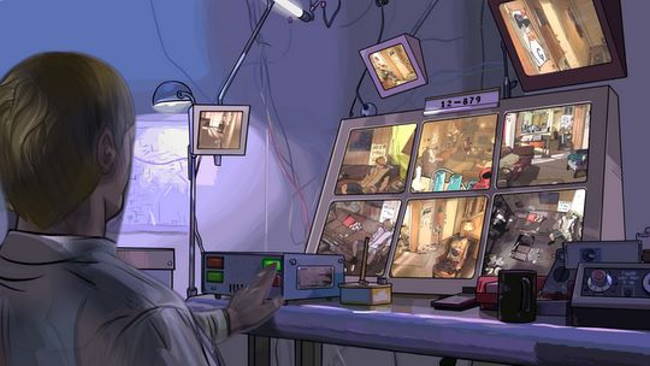
Overview: In a very faithful adaptation to Philip K. Dick’s story of the same name, Linklater treats us to an interesting, slow moving story about abuse – abuse of power, drug abuse, abuse fo friendships, and abuse of the self. While most of the publicity about Scanner Darkly is about the rotoscoping technique used, the story itself is good enough that it probably could have worked in live action as well. A Scanner Darkly is engaged in a slow-opening process – hopefully you all get to see soon in a theater near you.
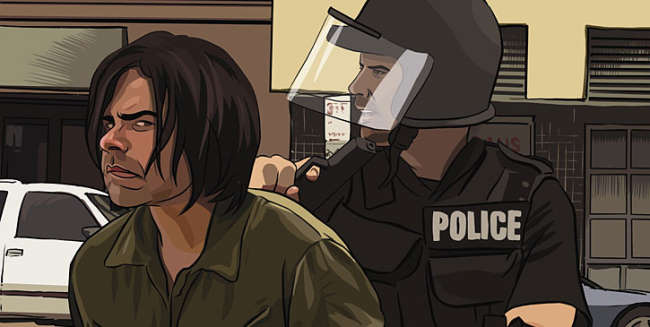
The Setting: Seven years into the future, a drug known as Substance “D” has transformed society. People are divided into addicts and those who haven’t taken Substance “D.” Society is quickly collapsing. In response to this threat, the government has transformed the society into a surveillance state, where neighbors spy on neighbors, and personal freedoms have been minimized. Everything is organized for instant observation – license plates are now bar-coded, and security is all DNA based. Trust has all but vanished in the world where Scanner Darkly resides. In its place, we have people who are constantly concerned about each other’s ulterior motives, and think nothing of stabbing someone in the back if only to win short term gains.
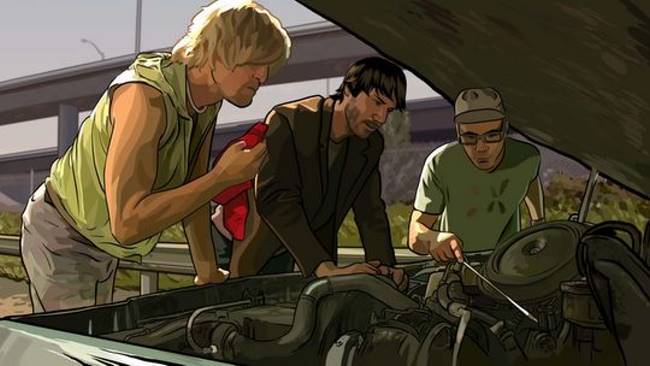
The Story: Scanner Darkly takes place seven years into the future and follows the plight of a close-knit group of addicts living outside of Anaheim, California. Bob Arctor (Keanu Reeves) is works as a reluctant undercover police officer (called “Officer Fred” at work), who lives with group of addicts that he eventually needs to perform surveillance on. Bob no longer believes in what he is doing, but still goes through the motions. At work, all the police wear “scrambler suits” to ensure nobody knows who they are. As the story progresses, we get to see the absurd lives that each of the addicts lead. Bob’s girlfriend (Winona Ryder) is a coke addict who freaks out if touched; his friend Charles (Rory Cochrane) sees insects crawling over him at all times, and his two room mates are clearly fried beyond all recognition.
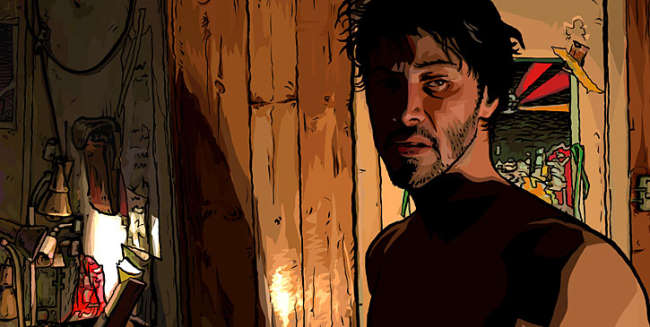
Unfortunately for Bob, his addiction is growing too. His grasp on reality starts to weaken as the hallucinations increase. He starts seeing his room mates as huge insects. Worse, one of his room mates (Robert Downey Jr.) visits the police department to narc on Bob. Bob, as the disguised Officer Fred, has the task of taking down his room mate’s statements and investigating them. As the movie proceeds, Bob becomes more disillusioned with his job and life, and begins to realize that he is losing his humanity.
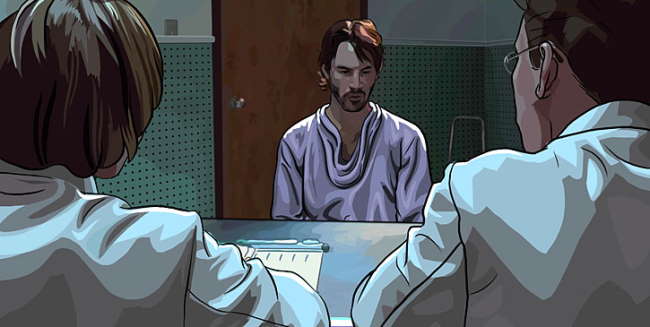
An Excersize in Duality: Scanner Darkly sets a number of issues up in a duality. We have left brain – right brain separation as a side effect from extreme exposure to Substance “D,” we get surveillance and security opposing personal freedoms, and the two doctors treating Bob overtly represent the left and right hemispheres. Everything in Scanner Darkly is about dualities of tension, and the descent of humanity in the face of this tension.
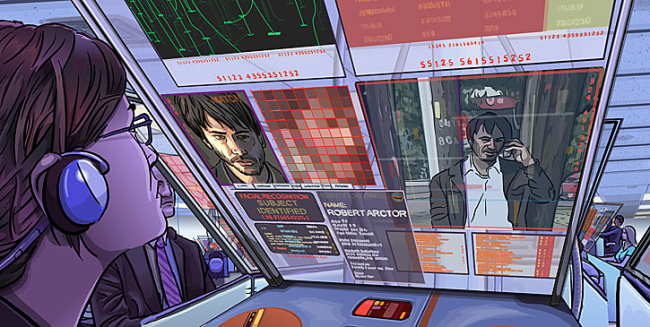
The Paranoia: A Scanner Darkly delves into the paranoia mindset that develops when drug use combined with an out of control surveillance society has taken hold. Personal rights and individual freedoms are significantly subordinated in a society where the government is after the supposed drug barons. One begins to question, however, whether the drug barons themselves are just yet another tool by the government to gain complete control over the population. The idea of government abuse of power permeates virtually every scene. The ranting sessions within the drug addict group are all based on paranoid delusions about what the government is currently doing to them. Worse, some of their “paranoid delusions” end up being true!
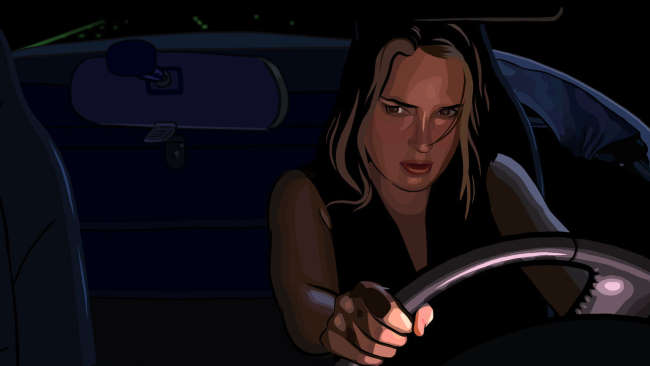
Drugs Are Bad, K? Scanner Darkly pounds this message in as many ways as possible. Wanna screw up your perception? Substance “D” is for you! But don’t worry, its effects are not always permanent, just most of the time! Within the addict group, we see different people in various states of insanity. The message is clear – once you’re on this stuff, the descent into insanity is all but assured.
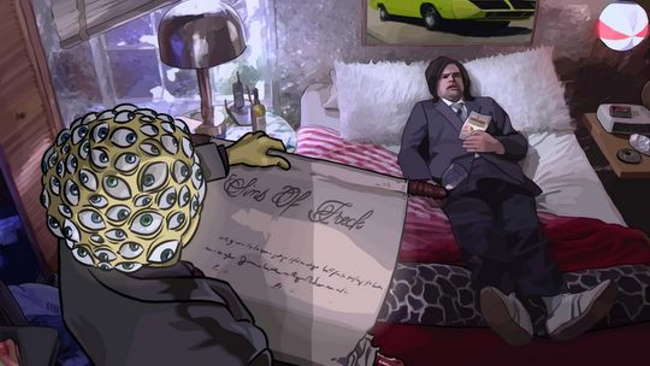
The Rotoscoping: The rotoscoping in Scanner Darkly works well as a device to create an atmospheric, otherworldly film, even though most of the scenes almost came off as red-neck central. Unlike Waking Life, where the hand drawn animation on top of live action is wildly uneven (on purpose) with the characters, for the most part the rotoscoping just gives it an ambiance. Also, the rotoscoping provides a wonderful base for the various hallucinations that happen in the course of the movie. Linklater’s rotoscoping technique seems to work best when there isn’t that much action on-screen. In some of the movement scenes (car riding, running, etc.), there is almost no difference between the rotoscoping and live action. There was also a lot of variances with the black lines around the faces – mostly this was pretty subdued, but in a few scenes, the black lines almost dominated the scene.
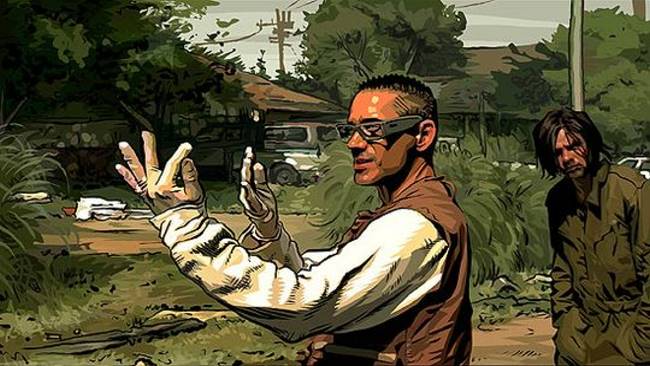
The Acting: For the most part, the acting is terrific in Scanner Darkly. Robert Downey Jr. especially shines, but Reeves’ performance fits perfectly for a man overtaken by events. Winona Ryder has some pretty solid moments (especially at the end), as does Woody Harrelson and Rory Cochrane. The better scenes usually involve Downey and another character involved in truly bizarre conversations. Some with Downey and Harrelson in particular are pretty funny.
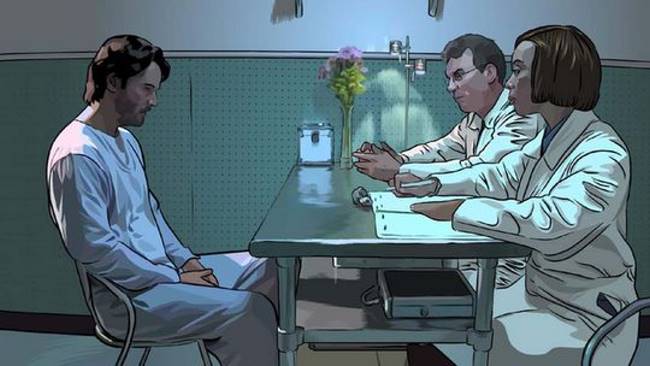
The Bottom Line: A Scanner Darkly is a movie with great acting, interesting discussions and a very powerful ending. That said, some parts of Scanner Darkly come off as overkill (the drugs are bad part, for instance), whereas others could easily have benefited from more elaboration. Still, these are minor complaints, as the overall movie has terrific acting, a great score (by Radiohead), and an interesting, well constructed message. Fair warning though - this is NOT an action movie. The vast bulk involves people milling around and talking, without any real action ever taking place. As long as action isn’t necessary for you to enjoy a good cyberpunk flick, give Scanner Darkly a try.
~See movies similar to this one~
Movie Review By: SFAM
Year: 1980
Directed by: Fred Barzyk & David R. Loxton
Written by: Diane English & Roger Swaybill (script), Ursula K. Le Guin (novel)
IMDB Reference
Degree of Cyberpunk Visuals: Low
Correlation to Cyberpunk Themes: Medium
Key Cast Members:
George Orr: Bruce Davison
Dr. William Haber: Kevin Conway
Heather LeLache: Margaret Avery
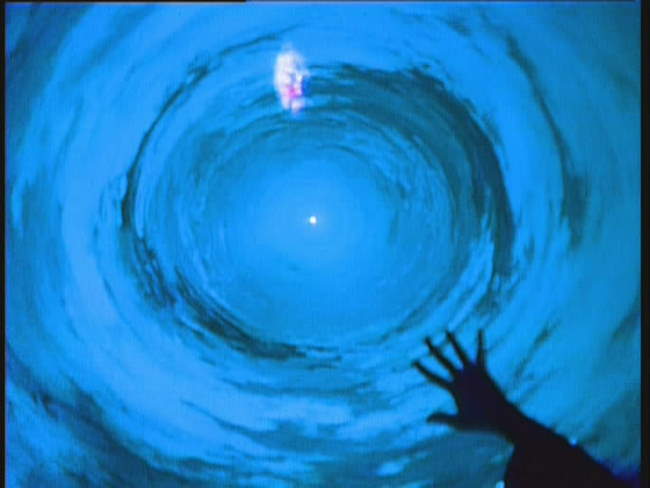
Overview: Lathe of Heaven is one of the classic SciFi books by Ursula K. Leguin. The 1980 adaptation (unlike the 2002 version) stays pretty faithful to the book, and is a very well done low-budget made-for-TV movie. Unfortunately, the original master was lost, so the DVD transfer was taken from a VCR recording of the 1980 TV broadcast. The quality isn’t great, but the story more than makes up for it. Lathe of Heaven is as symbolic as much as it is a narrative. Overall, the film provides an immersive experience with a truly interesting ending.
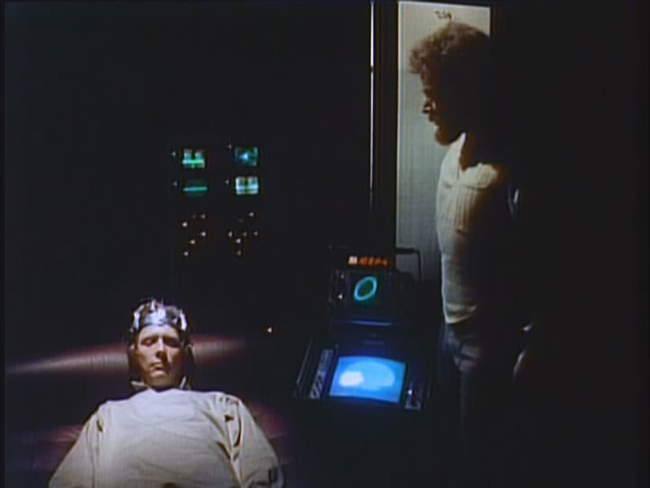
The Story: Thirty years into the future, the world has been decimated by a nuclear holocaust. George Orr (Bruce Davidson), having just been exposed to massive radiation lays dying. Somehow his body is changed, and he has the power to “dream” the world back into existence, just as it was, but without the nuclear holocaust. He forgets that this has occurred and tries to live his life normally, but is continually plagued by dreams that can effect changes in reality. In this dystopic, controlling future, he is forced to undergo psychiatric therapy, and is assigned to Dr. Haber, an expert in dream problems. George is looking for Dr. Haber to “cure” him, but Haber has other ideas.
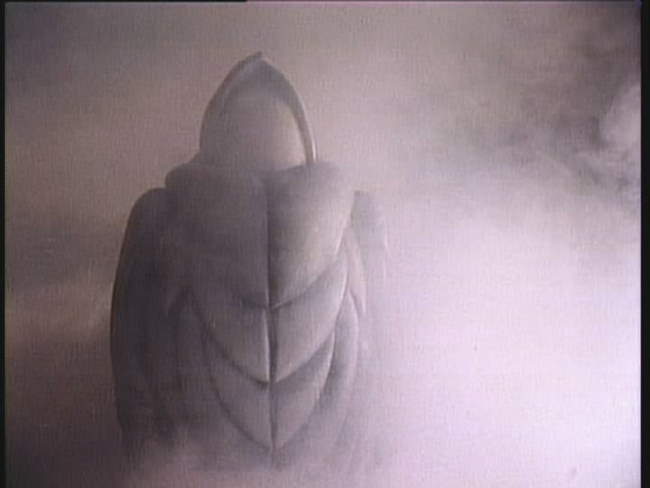
Dr. Haber quickly realizes that George is not crazy, but in fact possesses the most powerful gift ever given to man. Haber sees this as an opportunity to reshape the humanity and the world itself to become the ideal place that Man has always intended. Haber, using his dream-enhancement technology, asks George to have an effective dream about removing pollution. George does, but ends up removing all clouds, leaving the earth ever increasingly hot and dry. Haber forces George to dream of a way to cure overpopulation – this results in a plague that kills of 75% of the world’s population. Haber forces George to dream of peace on earth which results in an alien invasion that unites humanity but which can lead to the destruction of the earth itself.
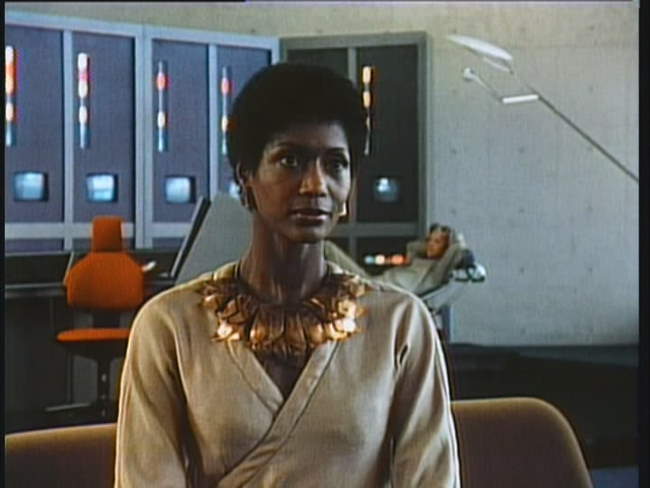
Even though Haber feigns ignorance of what’s really occurring, George quickly figures out that Haber is using him. Unfortunately, George doesn’t have the force of will to truly confront Haber. Instead, he enlists the services of a lawyer named Heather (Margaret Avery) to help get his psychiatrist changed to someone other than Haber. Unfortunately, when Heather goes to visit a session, it is already too late, as George’s effective dream has just killed off 75% of the world’s population.
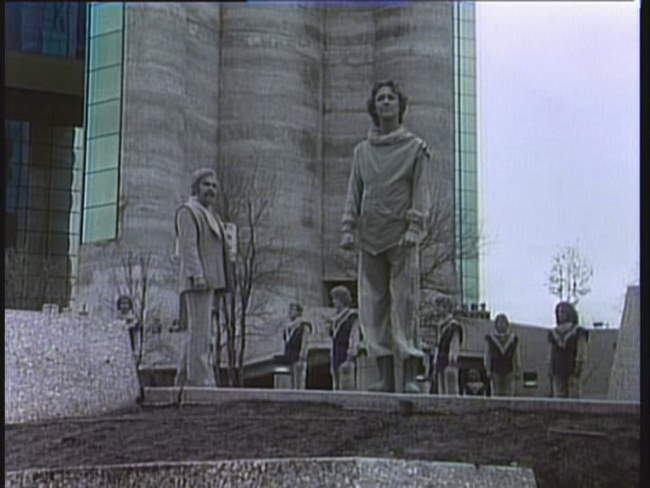
This pattern of George leaving, and returning continues, finally resulting in Haber forcing George to dream of removing racism (which results in everyone becoming gray) – Haber’s real purpose is to capture and duplicate George’s powers through his dream machines. Haber decides that the maladies are caused by inadequacies in George, and that he, an enlightened scientist will be able to have pure dreams that will result in the betterment of mankind. Unfortunately, when Haber dreams an effective dream, his results in a dream that will “unmake” reality. Only George can come and try to challenge Haber to a test of wills to bring a semblance of reality back.
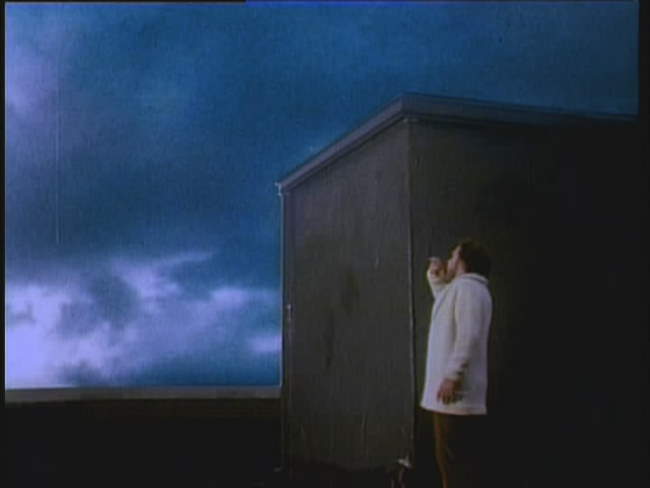
Taosim versus Positivism: Lathe of Heaven sets up a dual between a Taoist philosophy of participation versus a positivistic one. George Orr, representing the Taoist philosophy, is perfectly willing to let the world take its own course. Even though he has the power to change the course of humanity, he prefers to go with the flow, and understands that overt and specific changes to a very complex and interdependent world will result in disaster. Dr. Haber represents the positivist view, and sees technological advancement as the primary means of improving the human condition – moreso, he believes his duty as a scientist is to utilize George’s gift to transform the world for the better. After experiencing a series of continually worse impacts to the world when forcing George to use his power, Haber finally decides the problem is with George’s unconsciousness. It never occurs to him that the real danger is in converting George’s power to a technology that can transform reality.
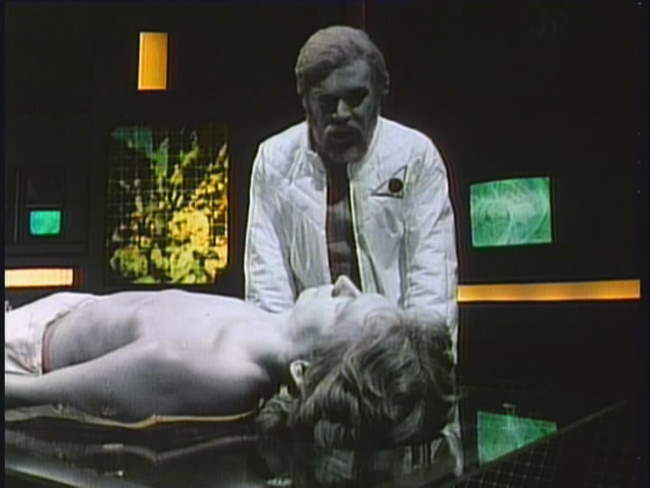
Le Guin’s message is clear: incredible power, especially augmented by technology, cannot be used in a simplistic way to transform a reality which is complex and intertwined. Instead, those interested in change must “go with the flow” of reality and change the human condition within the context of there normal interaction. The use of dominating power over nature will result and a dystopic future. This is in fact what Lathe of Heaven portrays.
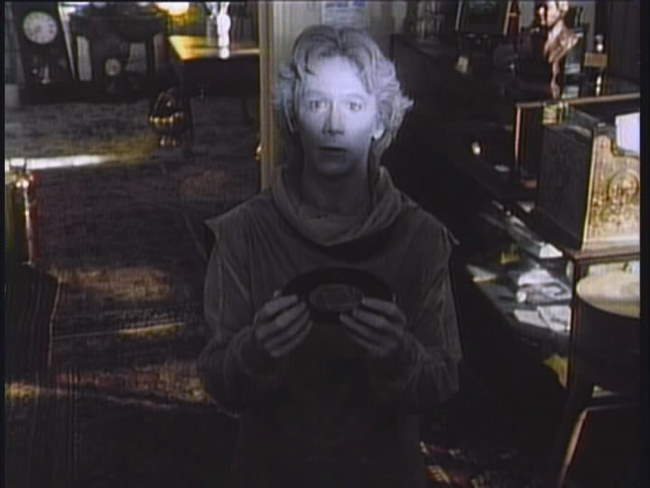
Is Lathe of Heaven Cyberpunk? I do agree that Lathe of Heaven at best is a cyberpunk fantasy. I include it here primarily due to the use of technology, invented for the purpose of human betterment, that ends up instead almost destroying humanity. Haber’s dream enhancement technology results in increasing George’s capabilities, and ultimately leads a true cyberpunked future. Human diversity is quashed when everyone left alive (after the plague kills over 75% of the population) turns gray. Individuality is suppressed in an attempt to eliminate conflict. In the end, the message is a similar cyberpunk theme – the use of technology to remake the perfect society results in a dehumanized, sanitized dystopia.
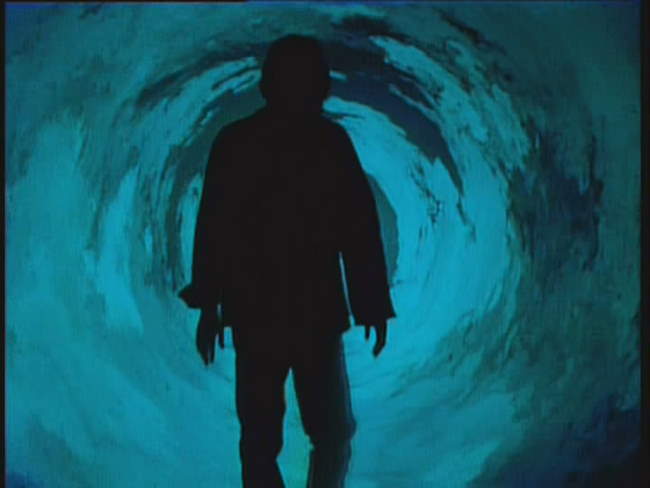
The Bottom Line: Although low budget, the Lathe of Heaven is effective in transforming a very philosophical book to a motivating film. The dual of Taoism versus positivism is mirrored in the colors, where the Taoist earth tones dual the technological grays and whites. The three leads deliver quality performances, and the story itself is captivating. While some of the FX are suspect, and the quality of the DVD is poor (the original master was lost), Lathe of Heaven is well worth a watch.
~See movies similar to this one~
Movie Review By: SFAM
Year: 2002
Directed by: Steven Spielberg
Written by: Philip K. Dick (short story), Scott Frank & Jon Cohen (screenplay)
IMDB Reference
Degree of Cyberpunk Visuals: High
Correlation to Cyberpunk Themes: Medium
Key Cast Members:
Chief John Anderton: Tom Cruise
Pre-Crime Director Lamar Burgess: Max von Sydow
Agatha: Samantha Morton
Danny Witwer: Collin Ferrel
Evanna (John’s Wife): Jessica Capshaw
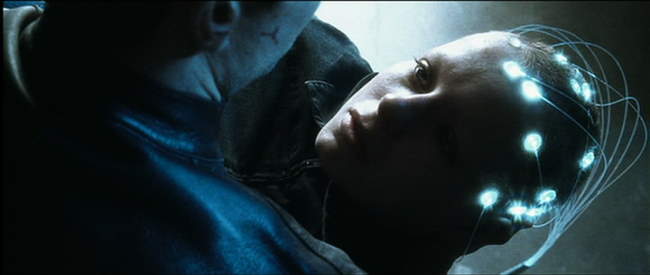
Overview: Minority Report, directed by Steven Spielberg, is another one of the large scale production cyberpunk movies that cleared a hefty gross (358 million worldwide, not counting DVD sales). Minority Report works both as a summer blockbuster (it was released in June), but also as a fairly intelligent cyberpunk flick. Based on another terrific story from Phillip K. Dick, Minority Report has a terrific cast headed up by Tom Cruise and Max Von Sydow, awesome special effects, and terrific music and sound FX throughout.
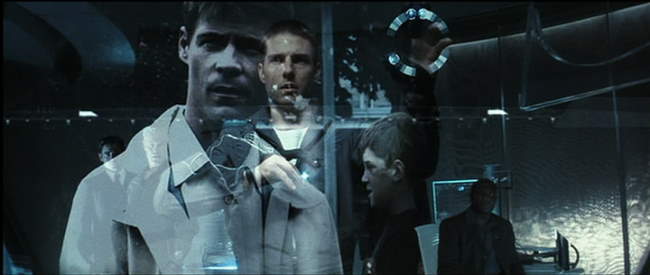
The Story: In Minority Report, Tom Cruise stars as John Anderton, a police chief at the head of an elite pilot police program, now in its sixth year, that prevents crimes BEFORE they are committed. The year is 2054, and the ability now exists within gifted, but altered people called “precogs” to tell when someone is about to commit a crime. The Precogs, comprised of two twins and one woman, Agatha (played wonderfully by Samantha Morton), are kept at all times in a dreamlike state in strange pool of water. The Precogs receive visions of murders that will be taking place. Based on an elaborate system that works off the Precogs, the police are able to extract the visions and are given the names of the murder victim and the murderer on color coded balls. Based on this, all premeditated murders have become a thing of the past – now the only murders that “might” take place are the crimes of passion, or “red balls” in Minority Report terms. When a red ball comes, the John Anderton must quickly work with the dreams to find the location of the murder (which often is only a few minutes or hours into the future) so that his team can rush to prevent it.
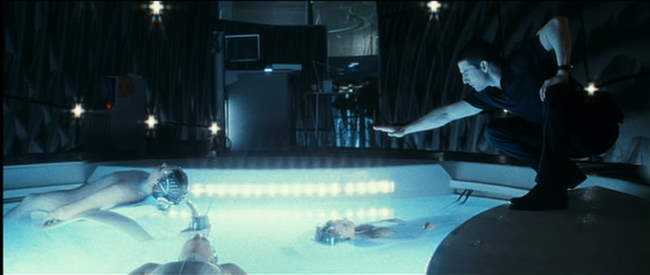
The end result of this technology is that people are being imprisoned for the crime PRIOR to committing it. Those who are identified by the Precogs are immediately sentenced to a strange virtual prison, where they are stuck in perpetual dreamstate (no word is given why they aren’t relegated to a normal prison). Through a quirky situation, John Anderton is brought in close proximity to the Precog, Agatha – she grabs him and fervently relays a vision that has occurred in the past. In tracking this down, John Anderton learns that sometimes one of the three Precogs actually deliver a vision that differs from the other two. This vision, termed a “Minority Report” is quickly discarded so as not to be seen as threatening the integrity of the process.
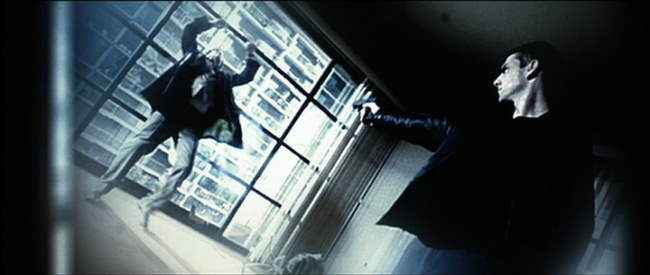
Anderton, plagued by the death of his son by an unknown assailant prior to the Precogs, has traditionally been the program’s biggest proponent. However, after learning of the Minority Report, he becomes concerned with the possibility that he has in fact been putting innocent people away. But unfortunately, his investigation into this matter has created powerful enemies. A new red ball vision is created, only this time Anderton finds out that HE is supposed to commit a murder in 36 hours. Convinced that he has been unfairly targeted, Anderton escapes from his former team and goes on a crusade to clear his name. His plight forces him to replace his eyes (used for retina scans at all security posts), and eventually takes him to the bottom of the Pilot Program’s seedy beginning.
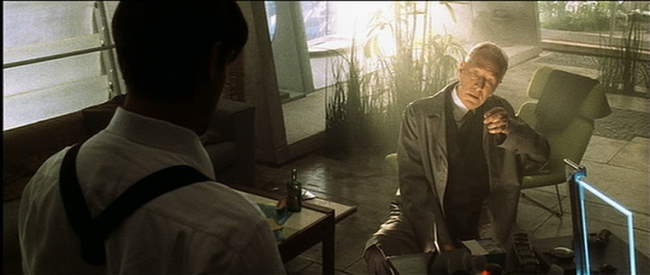
Story Issues : Nevermind the issue that the creepy hacker dude is able to jury-rig a vision scanning and extraction device faster than Scotty can fix a warp drive, Minority Report has a major issue with the technology that’s really never taken seriously – the issue of freewill. If precogs really can see into the future and determine that someone “will” murder their intended victim, this negates the ability of choice at that last instant of the murder. While this is eventually addressed (no spoilers), there is no rationale provided for why freewill was ignored. In the end we are left with believing that over-zealous law enforcement personnel were able to convince the entire country to take this approach. While this is a fine plot point, it would have been far more believable had their been some indication that they actually had to do a massive conving job.
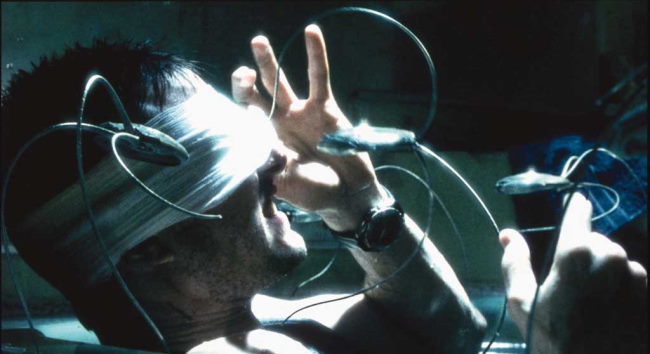
The Eyeball – the Ultimate Security Breach: The other issue with the story that really defies believability is that when John Anderton is caught, he is CONTINUALLY able to get back into the most secret areas of Police HQ by using his former eyeballs, which he keeps with him in a plastic baggie. Even though the police know he’s on the lamb, the apparently don’t feel the need to revoke Mr. Anderton’s security access privileges. This is all the more disbelievable considering EVERYTHING in society is apparently keyed off a retina scan. Sure, OK, perhaps one time they lapse on this, but three times??? Common Steven – you’re too good a story teller to let that one slide.
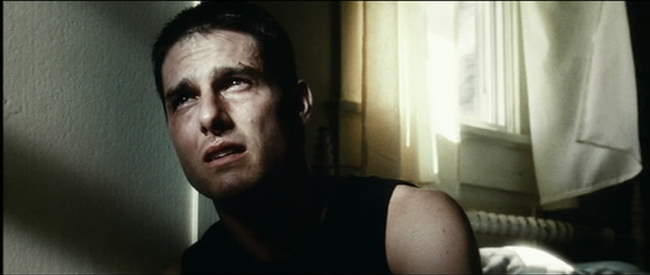
The Visuals: The visuals are sleek and well integrated, with some nice aqua and blue tones throughout. Interestingly, Spielberg usually goes with an overexposed type of shot to make it look almost as if one is looking at a dream sequence. Continually, we get white saturation dominating the shots. While this approach sounds weird, it ends up working wonderfully in adding to the mood of a cyberpunk film that has a massive focus on visions and dreams. As always, Spielberg gives us a plethora of truly unique visuals and mood shots. The best of the movie comes when Agatha
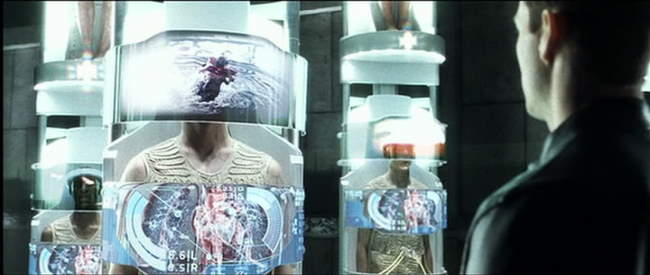
The FX: Minority Report consistently has absolute top-notch FX that adds interesting elements to the story. From the strange spider surveillance things, to the Boba Fett Police Podships, to the mixed modern cityscapes, the world of Minority Report comes off as a truly odd cyberpunked future. At some level, everyone seems to be living normal lives. Yet every now and then, we get a sense that the surveillance society has taken hold to the point that people have all just accepted it.
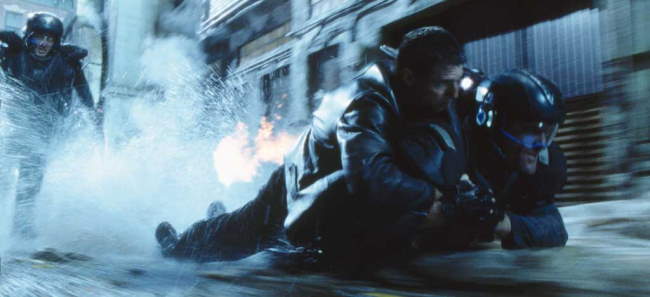
The Bottom Line: The overall mood and FX in Minority Report are terrific. The acting is great - Cruise has rarely been better, but also Von Sydow as the Police Director, Collin Ferrel as the scheming FBI agent, and Samantha Morton as the Precog are all terrific. The FX and sound If you buy the technology, chances are you give Minority Report at least a 9 or 10 star rating. Unfortunately, I did have problems buying some of this. Regardless, the story issues don’t take too much away from a very worthy cyberpunk film.
Page 2: More Screencaps–>>
~See movies similar to this one~
|




























































































